-
Welcome!
Thanks for swinging by my vintage Barbie fan site, where you’ll find articles on Barbie’s built environment, Barbie illustrations, vintage clone dolls (though we haven’t dug into this topic much yet), and general musings. What are you looking for?
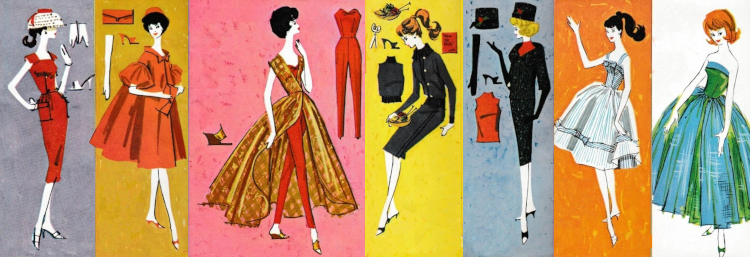
Vintage Barbie Illustrations
- Mattel fashion booklets, 1960-67 (approximately)
- Basic and Dressed Doll Boxes, 1959-64
- Doll Carrying Cases, 1961-72
- Jumbo Trading Cards, 1962
- Gift set art, 1960-70
- Random House books (plus some from other publishers), 1962-65
- Dell Comics, 1962-63
- Whitman Paper Dolls, 1962-65 and 1967-73
- Whitman Coloring Books, 1962-65 (A mod sequel post is possible but not planned at this time.)
- Queen of the Prom board game, 1961-63
- Keys to Fame board game, 1963
- Sew-Free Fashion Fun Kits, 1965
- Sewing Patterns, 1962-?
Plus the illustration “sidebars,” short entries on niche topics:
- Busy Gal fashion sketches, 1960
- Barbie Sings!, 1961
- Color Magic, 1965-66
- All the Barbie and friends illustrations on mod house exteriors like the one below
- The illustration component of the 1964 Little Theatre and travel costumes entry is sidebar-sized.
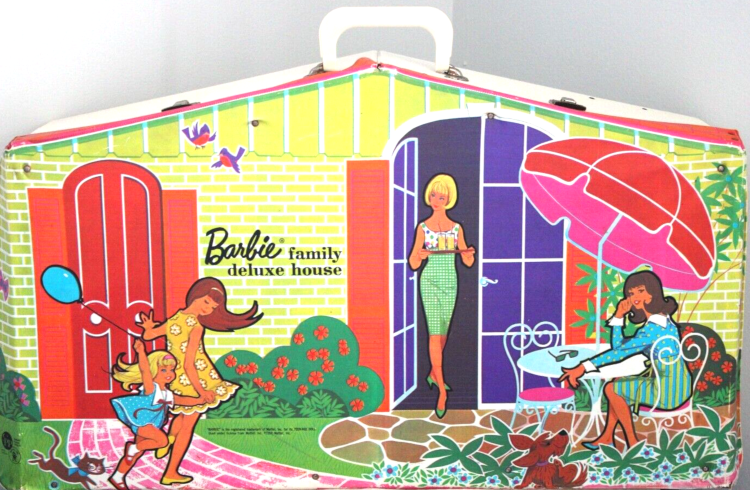
Barbie’s Built Environment
- Entries by year for many of Barbie’s early abodes: 1962, 1964, 1965, 1966, 1967-68, 1969, 1970.
- Mattel Modern and Susy Goose furniture, 1958-1966
- Barbie on TV, a roundup of some of Barbie’s early toy TV sets (this post also has a strong “illustration” component)
- Not Barbie on TV: Barbie and friends’ early TV sets that were tuned in to other programs
- Barbie’s Fashion Shop, 1963
- The Deluxe Reading Dream Kitchen, 1963 (note, this is not a Mattel product)
- The Little Theater, 1964
- Skipper’s Schoolroom, 1965
- Penthouse apartments, 1964-76
- Beauty parlors, 1964-77
- Unique Boutique and Cafe Today, both 1971
- The Sears Karosel Kitchen, 1971-1976 (note, this is not a Mattel product)
- A roundup of fireplaces in Barbie and Barbie-sized houses, 1963-79
- The “built” environments of Whitman Barbie paper dolls, which real Barbie dolls can also use; 1963-1973.
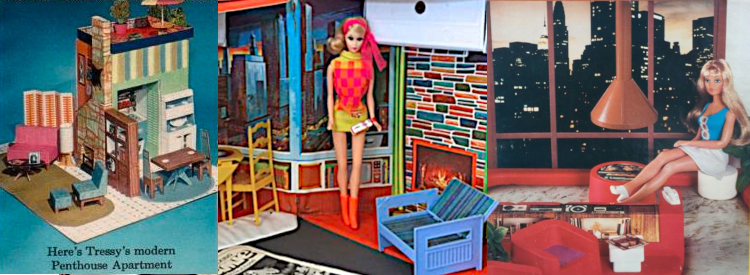
Articles relating to clones or off-brand Barbie-style products
- Clones are recommended in the “existing alternatives” section of the musing, Three Nostalgic Black Barbies We Need (and a few existing alternatives).
- Clone kitchens: The Deluxe Reading Dream Kitchen, The Sears Karosel Kitchen
- The pieces on penthouses, beauty parlors and fireplaces include non-Mattel offerings.
- The entry on Mattel Modern and Susy Goose furniture includes some offbrand furniture items of the 70s and 80s.
- We wrote about clone carrying cases, including some created for competitor dolls.
- Certain of the sewing patterns are for generic fashion dolls.
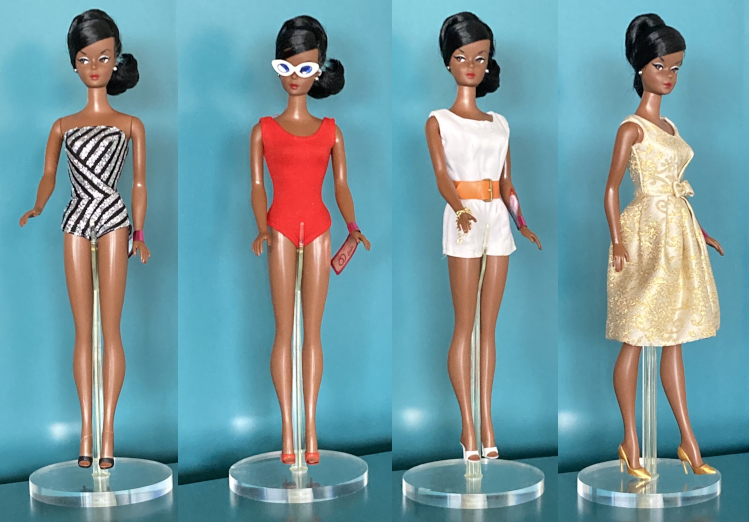
Miscellaneous Musings
- A Chronicle of Barbie shoes, 1959-67
- When Barbie Turned 21 in Manhattan, 1980
- Three Nostalgic Black Barbies We Need (and a few existing alternatives)
- One of our most-searched posts is about Books for Vintage Barbie Fans
- The piece on Skipper’s Schoolroom includes “play sets that never were”: Barbie’s Sixties careers for which environments were not produced.
- Visions of After Five (1962) and Solo in the Spotlight (1960)
- Who wore it best? pairs vintage and mod Barbie and Francie fashions with their likely or confirmed inspirations. The Airborne edition does the same for vintage flight attendant uniforms, while the Mary Quant one highlights Francie fashions that appear influenced by Swinging London designer Mary Quant.
There’s plenty more to come, but before you scroll down to the blog posts in reverse chronological order, here’s the first image ever posted to this blog: some of my dolls, dressed in vintage or vintage reproduction, in front of backgrounds belonging to Bill Cotter:
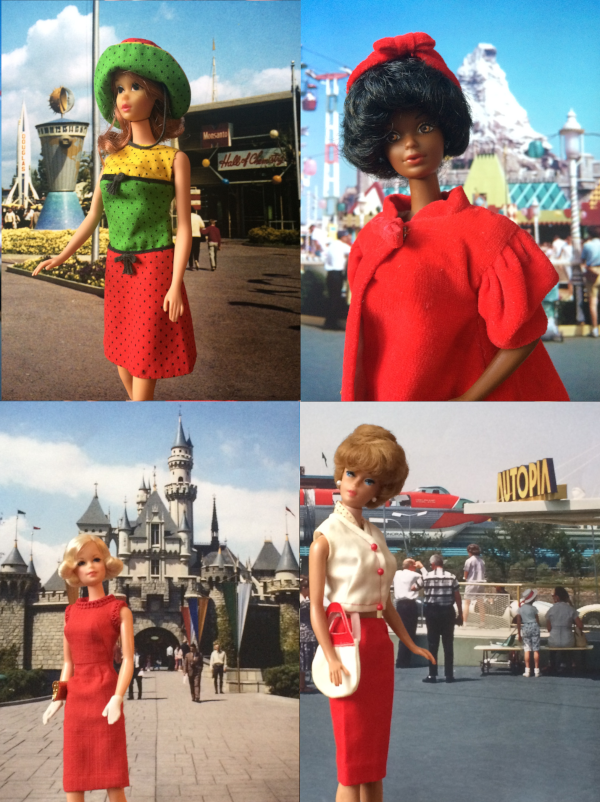
-
Cafe Today (1971)
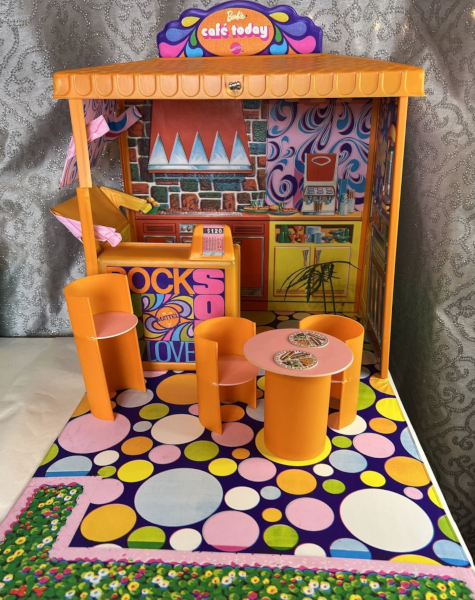
Source: kvitochki on eBay. Sixties Barbie was all dressed up with few places to go. There was the Little Theatre, but what’s “dinner and a show” without dinner? A show? Barbie’s only known 1960s eatery was not much of a restaurant, certainly not a nightclub: the Campus Sweet Shop was where Ken took Barbie for malteds, but she had absolutely nowhere to do this, or this,
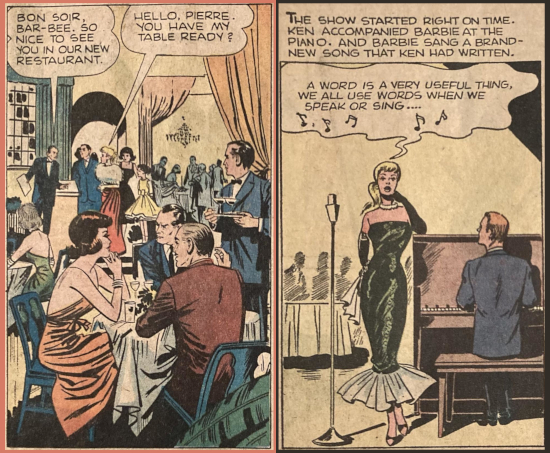
Source: Dell Comics or any of this,
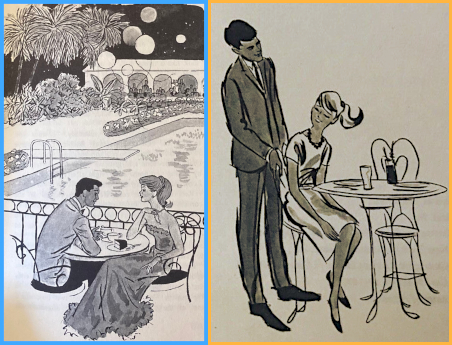
just this:
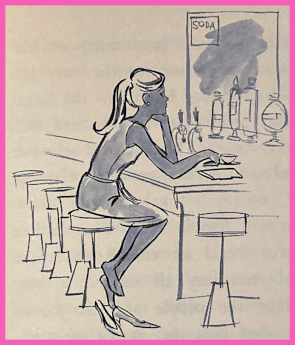
Source: Random House books. The 1971 Cafe Today play set didn’t help the situation. With burgers on the grill, soft drinks in paper cups, hot dogs on the table, and the counter window with awning outside, Cafe Today appears to be a hamburger stand.
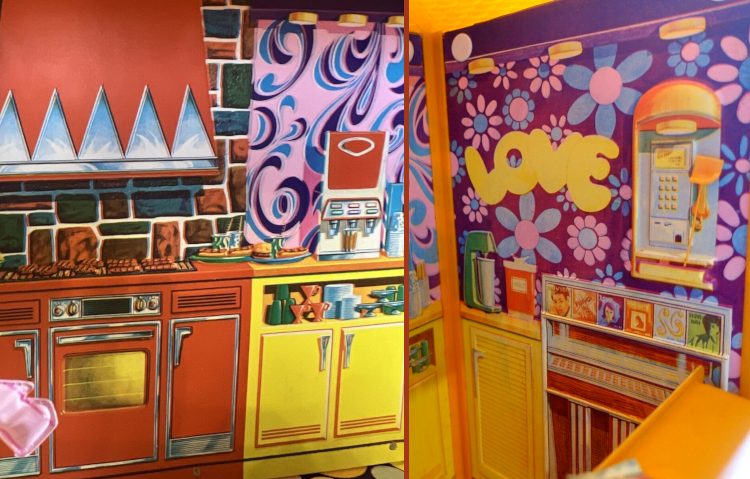
Printed interior details showing grill, soft drink dispenser, pay phone and ’70s-style jukebox. Ebay sources: supersebbe and kvitochki. We commend the interesting barrel chair design, at least:

Counter, chairs, and hot dogs. Ebay sources: sjsutherland-2, supersebbe. In her Barbie structures book Marl Davidson describes Cafe Today as a discotheque, but I think that’s being generous.
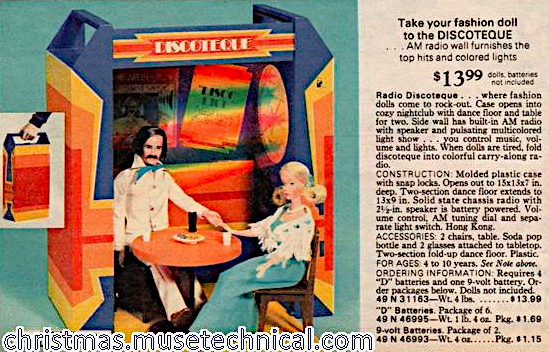
Now this is a discotheque (off-brand play set/working radio from Sears Christmas catalog, 1976). Would Barbie ever get to dine in style? This might be moving the goal posts, but I’ll venture the 1986 Barbie and the Rockers Dance Cafe, unquestionably a discotheque, as a fashionable place to see and be seen, drink and dance, possibly even get a bite to eat:
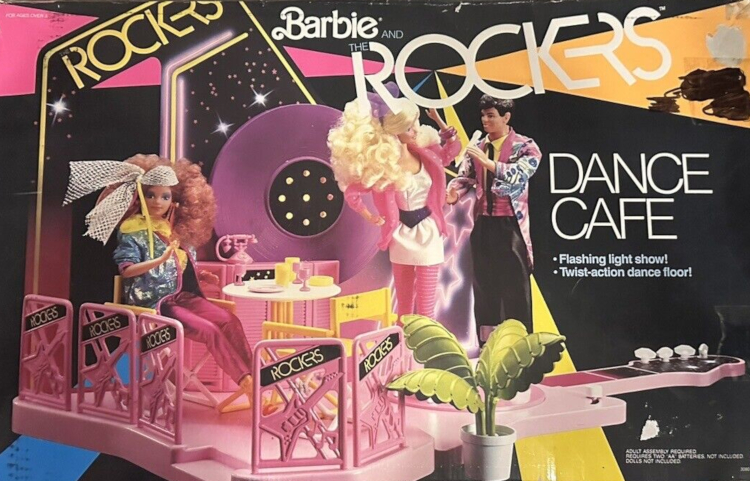
Stylish Mattel discotheque, via retrorodeo82 on eBay. Will Pierre, the maitre d’, greet Barbie by name at the Dance Cafe? Perhaps not. But at least she can be hounded by paparazzi on the way in.
Back at the Cafe Today things are comparatively laid back: jukebox blasting, sun shining and grill sizzling. It’s an informal hangout space to complement the Unique Boutique of the same year.
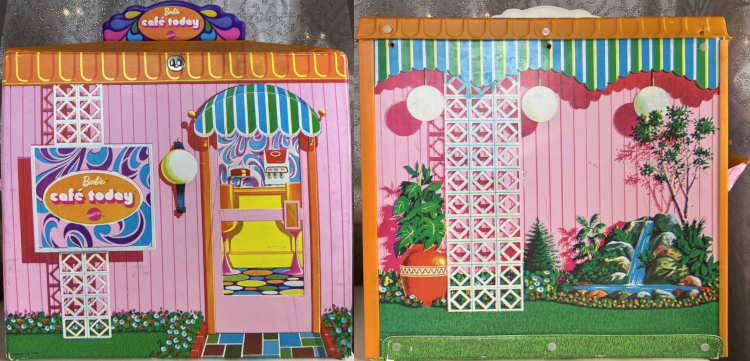
Cafe Today exterior front and back. Source: kvitochki on eBay. Glamour will have to wait.
-
The “built” environments of Whitman Barbie paper dolls
We talk a lot about Barbie illustrations here, and we talk a lot about Barbie’s play sets and furniture, but what about the built environments within Barbie illustrations? In our posts on Whitman paper dolls we featured some paper doll folder interiors that show Barbie’s home or place of work; in fact, there are many such folders worthy of consideration. These illustrations provided a backdrop against which to dress and re-dress paper dolls, adding a little immersion to the 2D doll experience. The set below is a perfect example.
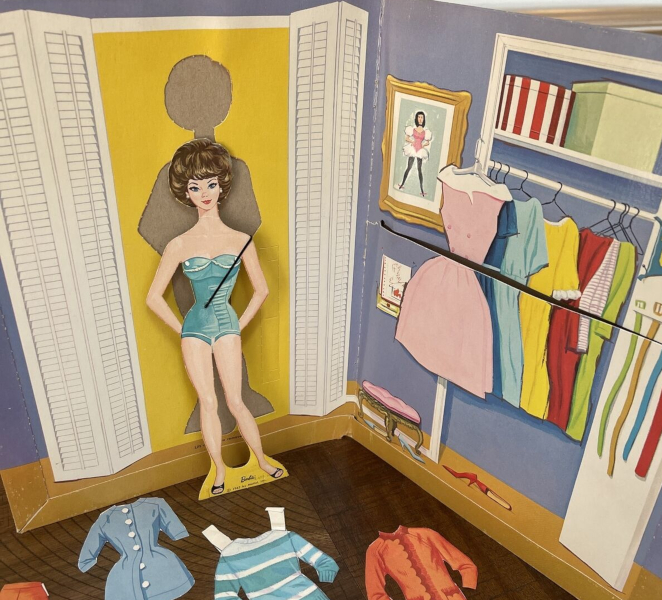
1963 Whitman Barbie paper doll set interior with doll. Source: PORCH SAFE on eBay. The illustrated interiors often show places where Barbie might dress, like this one depicting a changing room and closet. On the back of this folder is an illustration of Barbie posing before a full-length mirror, which we highlighted in our first post on the Whitman paper dolls.
A thematically similar design from 1966 shows either a boudoir scene or a store dressing room (since there are tags on all the dresses). We used this backdrop for a Francie/Casey photo shoot in a recent post.
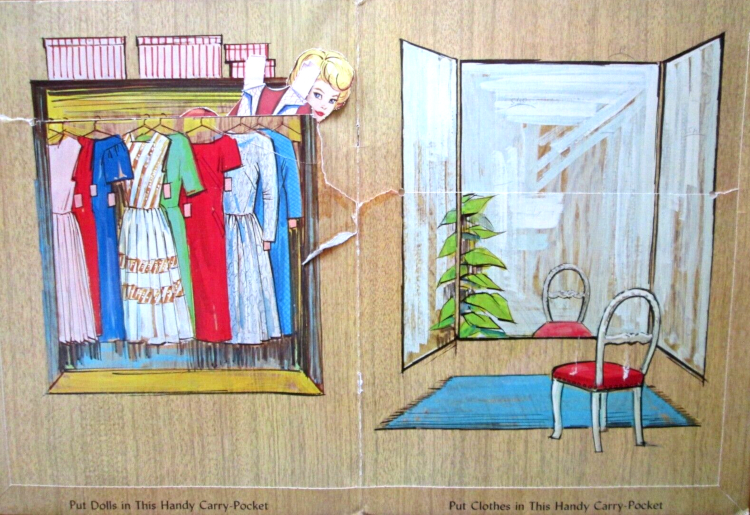
1966 Whitman Barbie Skipper Skooter paper doll folder interior, with dolls and fashions poking out of the lefthand pocket. Source: dianeb6182 on eBay. Midge’s changing area was decorated in a romantic style. As a backdrop for diorama or for imaginative play, this piece loses some immersivity due to its paper-doll-shaped holes (the missing Midges of this set are very cute, by the way).
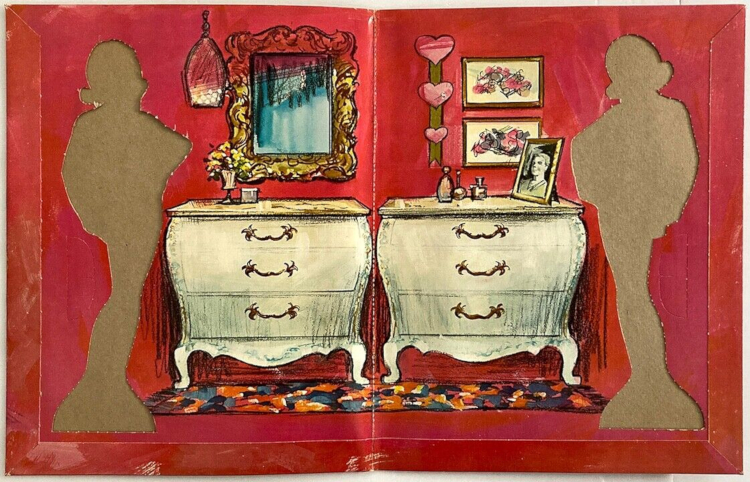
1963 Whitman Midge paper doll set interior. Source: harpagon-half on eBay. A different type of dressing room appeared inside the Little-Theatre-themed “Costume Dolls” set, which also included small versions of the Little Theatre’s stage backdrops. Since the Little Theatre itself has no backstage area, this folder makes a valuable addition.
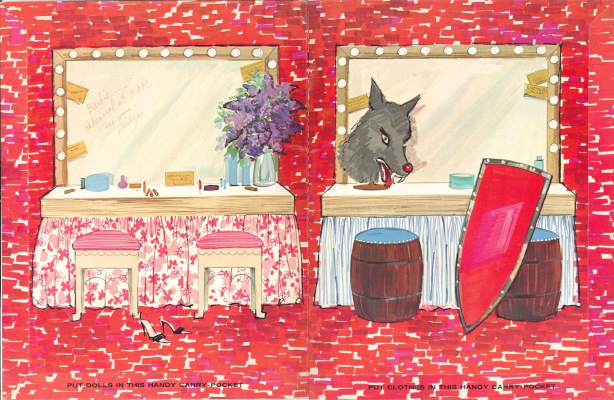
1964 Whitman Barbie Costume Dolls folder reproduction. Source: Arlene’s Vintage Paper Dolls on eBay. Barbie’s early-Sixties career as a fashion designer provided another setting in which dolls might get changed, below. We’re especially fond of all the sketches of authentic Mattel Barbie fashions shown, when the paper doll set itself contained few or no recognizable Barbie ensembles.
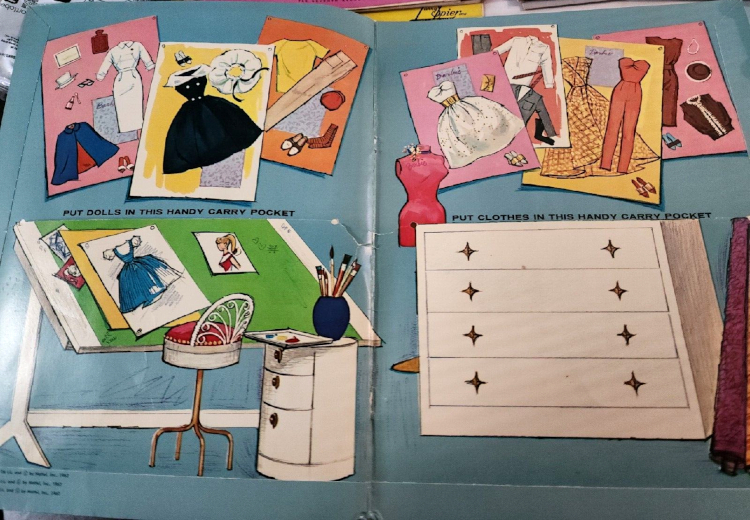
1963 Whitman Barbie, Ken and Midge folder interior. Source: Bees Knees Shoppe on eBay. At least once, a Barbie career was featured that did not immediately suggest dressing:
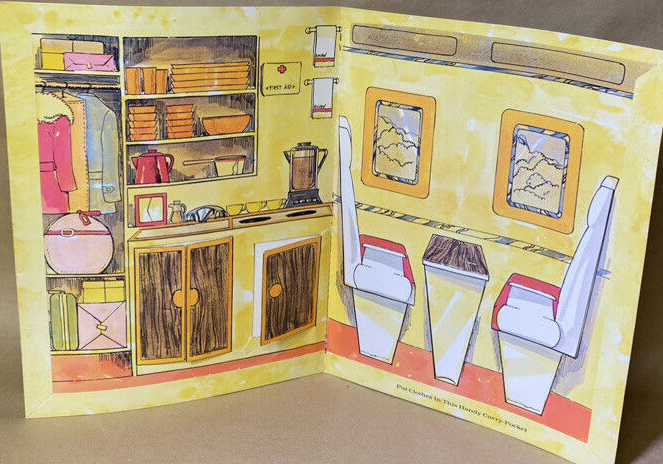
1973 Whitman Barbie’s Friend Ship paper doll folder interior. Source: Variety Company on eBay. although the Braniff air hostesses from a couple years earlier did have three costume changes per flight! We’ve demonstrated the use of this folder as a diorama backdrop in a couple of posts.
And other times, the illustrated setting was neither work nor home, as in the case of this drive-in burger joint:
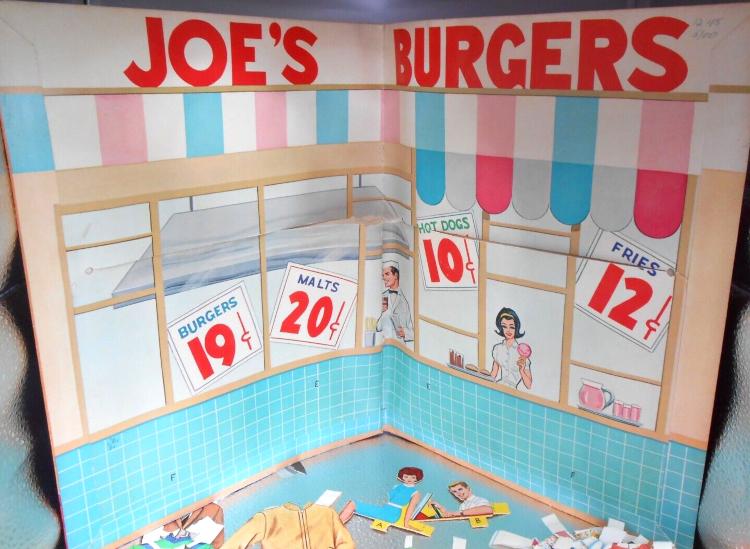
1963 Whitman Barbie and Ken paper doll folder. Source: Momma’s Hobby Vintage on eBay. To use it with dolls, paper or otherwise, the user must supply the car. The set did come with a small-scale paper car and small-scaled Barbie and Ken (lying in front of the folder shown above) to sit in it.
Lastly, at least one folder featured Barbie’s house with Barbie squarely in the scene. These illustrations, on a 1967 folder, show that year’s new T’n’T Barbie inhabiting the New Dream House, first available in 1964:
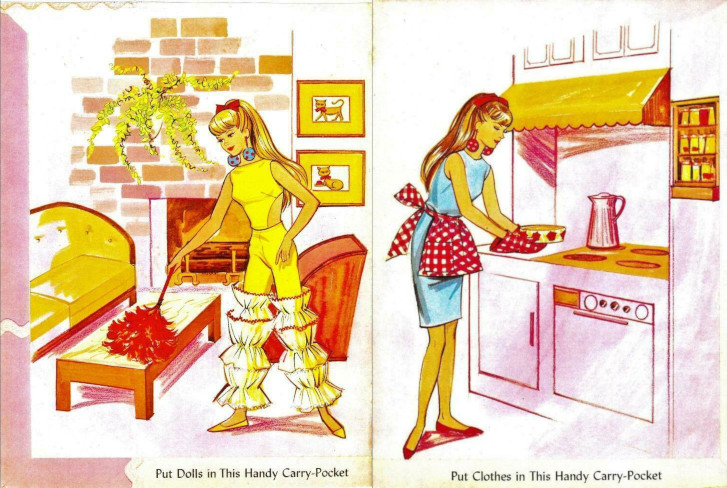
Inside the “Barbie has a New Look” folder from 1967. Source: onceagain34 on eBay. This is surely not an exhaustive list of built environments in the Whitman paper doll folders, although many folders featured illustrations less suited as a setting for imaginative play; in the Seventies the folders were phased out in favor of books with fewer ancillary illustrations.
-
Unique Boutique (1971)
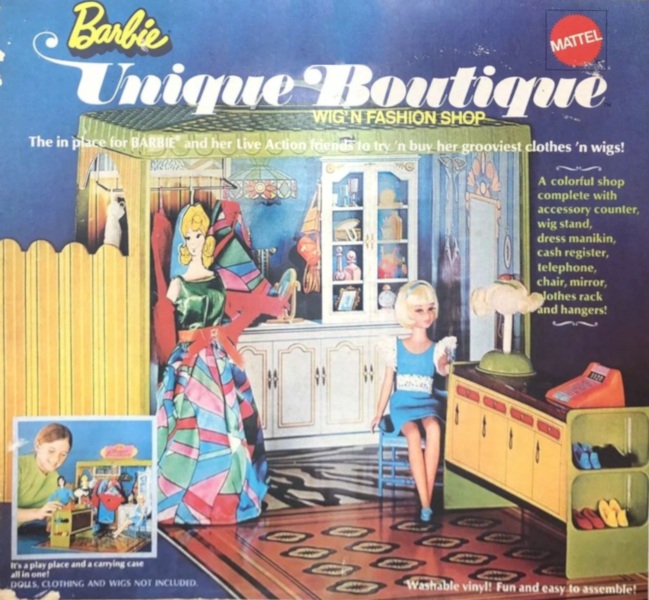
Barbie Unique Boutique package exterior During the second half of the Sixties, Barbie was a total homebody: following the release of Skipper’s Schoolroom in 1965, Barbie went through about a dozen homes, but no more public spaces. When she was finally ready to reemerge in 1971, it was into a different world.
Between the years 1963, when Barbie’s Fashion Shop debuted, and 1971’s Unique Boutique, clothes shopping underwent a revolution. In Vintage Fashion: a Complete Sourcebook, Nicky Albrechtsen explains: “Music, art and fashion interlinked to create a new culture, epitomized by the renowned informal boutique shopping experience… Boutiques stayed open ad hoc, a party atmosphere prevailing until the early hours, as consumers shopped listening to the newest music and the celebrities of art, pop and rock mingled with young shoppers all seeking forward-looking fashion that broke with convention.”
An early and impactful boutique reimagining was Mary Quant’s Bazaar store in Chelsea, which faced legal trouble in the 1950s for staying open too late, placing an unfair burden on the competition to do likewise. The boutique of Marion Foale and Sally Tuffin was another Swinging London staple, where the clothes were hung on overhead rails that stretched from wall to wall, surrounded by bare lightbulbs in red and blue. In his book on the pair, Iain R. Webb quotes a contemporary journalist describing Carnaby Street boutiques such as theirs as “like a club–the assistants just smoke and lean against the wall and put records on.”
Reminiscing for The New Yorker on his time living upstairs from trendsetting London boutique Granny Takes a Trip, Salman Rushdie wrote, “Inside Granny’s, it was pitch dark. You went in through a heavy bead curtain and were instantly blinded. The air was heavy with incense and patchouli oil and also with the aromas of what the police called Certain Substances. Psychedelic music, big on feedback, terrorized your eardrums. After a time, you became aware of a low purple glow, in which you could make out a few motionless shapes. These were probably clothes, probably for sale. You didn’t like to ask. Granny’s was a pretty scary place.”
Meanwhile in New York, Paraphernalia, serving the Warhol set with designs by Quant, Tuffin and Foale in addition to American designers like Betsey Johnson and Diana Dew, leaned more Exploding Plastic Inevitable: a vast, chrome-and-white interior with slides of the fashions projected on the walls. Johnson described it as “like stepping into a spaceship or into the future.” In all cases, music was blaring.
Mirroring progress in the real world, Barbie’s Unique Boutique, unlike the earlier Fashion Shop, has no stage for the store’s models to occupy, no armchairs and magazines for its customers. The space is narrow, an explosion of color and texture; you can easily imagine the records spinning… and you can practically detect the heady scents, as well.
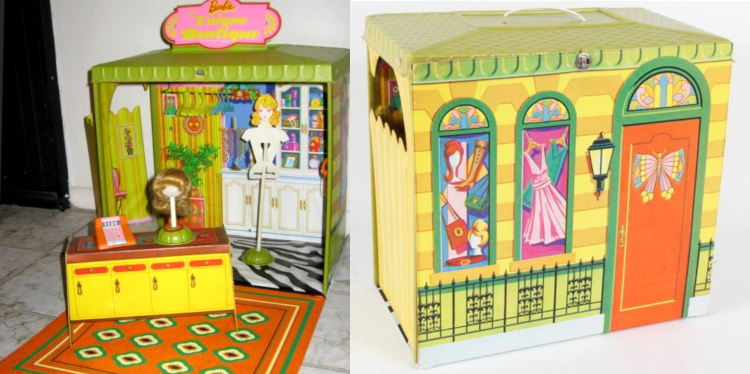
Left: vintage Unique Boutique interior including “manikin,” wig stand with wig, and cash register sitting on the counter/shoe rack. All that’s missing is that straight-backed plastic chair. Right: Unique Boutique exterior. Source: Ripley Auctions. Of the real-life Sixties boutiques we surveyed, we think the Unique Boutique shares the most DNA with Granny Takes a Trip–or maybe Biba. But Barbie’s London boutique phase was fleeting; her next forays into consumerism, in the Superstar era, would take place at indoor malls and department stores of a decidedly more American persuasion.
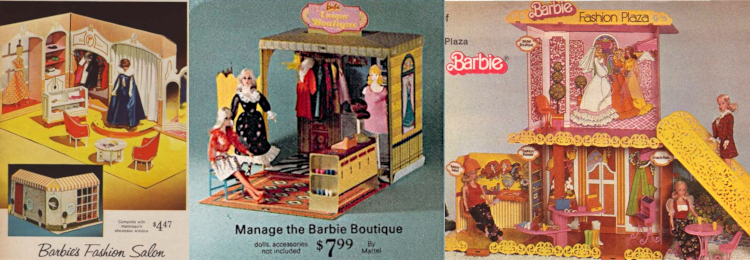
Barbie’s shopping evolutions in Christmas catalogs, 1964-1976. via WishbookWeb.com. -
The Many Abodes of Barbie, Part VII: 1970
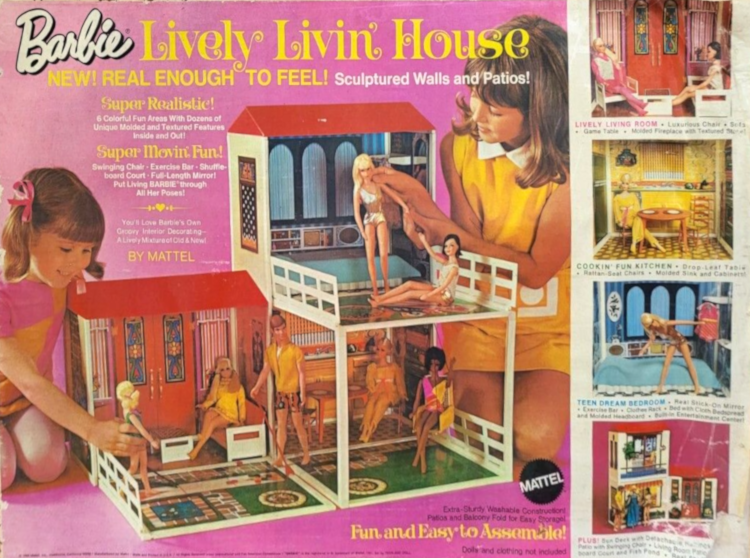
Source: slicksilver66 on eBay. In 1970 the best Barbie house arrived. A controversial statement, to say the least: of vintage Barbie Dream House enthusiasts, the chipboard diehards clearly feel differently, and for many plastic aficionados the great, timeless houses came later in the decade. However, we’ll present compelling evidence that the Lively Living House (and the Surprise House, which is the same) represented the acme of Barbie’s domestic adventures.
In terms of furniture this house had the usual for 1970, glimpsed above: the couch and chair with game board, the circular dining table with two high-backed chairs, the solid molded shell of a bed; one novelty was a swing chair hanging from the second-story balcony, occupied by Christie in the image above. The ’72 version, the Surprise House, also added a planter with seeds for growing real plants and some gardening implements in keeping with the country emphasis of the time. The furniture was just fine.
But the surprise house distinguishes itself in two key areas: the walls and floors.
Walls
Let’s take a closer look at that front room/living room, lower left in the box art that introduced this post:
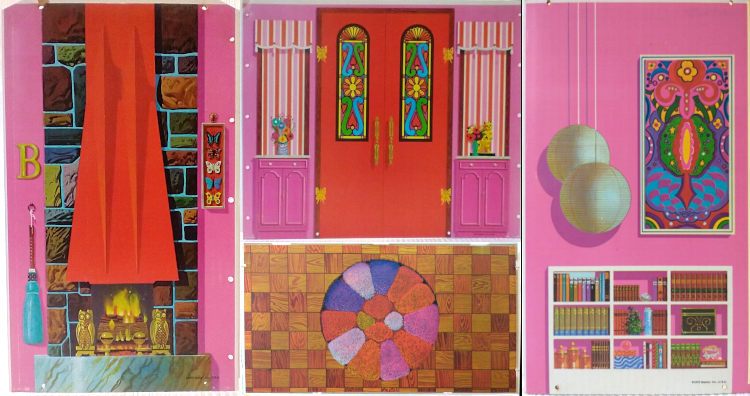
Walls and floor of one room of the Lively Livin’ House, via grozalis on eBay. Rich, colorful, detailed, midcentury-psychedelic. And here’s the kitchen next door:
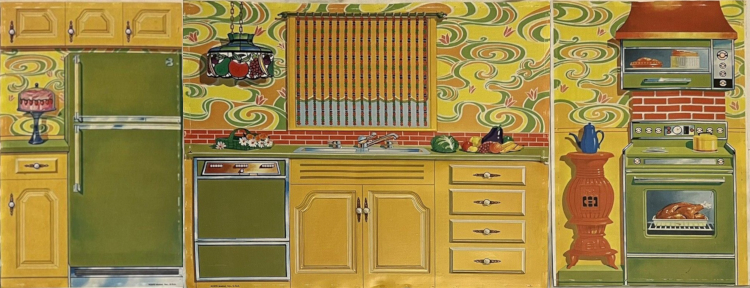
Walls of the Lively Livin’ House kitchen, via raregold on eBay. .That mad wallpaper! The avocado appliances! There is no more beautifully-styled interior in Barbie’s plastic dream home era.
And outside? We’ve noted that Barbie and her friends were illustrated on the exteriors of the Sixties mod houses. 1970 marked the end of that trend. Instead, the Lively Livin’ House walls are jam-packed with gorgeous furniture, plants, planters, etc. These panels enclose the living room and kitchen we surveyed above:

First floor exterior of the Lively Livin’ House, via grozalis on eBay. The chair and fountain would not be out of place in the original Star Trek series, while the stained glass and fieldstone chimney are all peak 1970 aesthetics.
In addition to the surfaces we’ve highlighted here, there was a bedroom in rich blues and purples, and three panels of garden walkways including a shuffleboard court. In a sharp pivot, this house didn’t fold up for carrying, but the three outdoor walkway panels did fold up to complete the house exterior with additional windows and decor and make it a bit more compact to store. The panels easily remove from the structures to serve as stylish backdrops for dioramas, and they are indestructible-ish vinyl, so they’re fairly common today.
Floors
When I named floors as a distinguishing trait of the Lively Livin’ House, I wasn’t talking about the appealing tiled floors that complement the walls detailed above. They’re great, but the real innovation of this house, floorwise, is this: as a two-story structure, it is the first Barbie home to have a second floor. Its multistory structure and lack of fold-and-carry capability set the precedent for more famous Seventies houses: the Townhouse and the A-Frame.
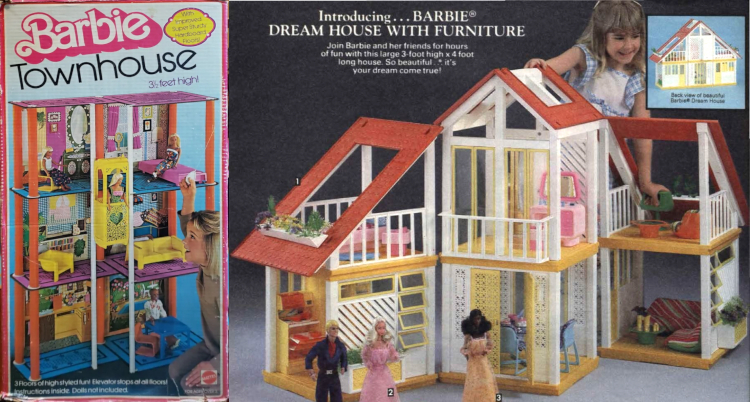
Famous houses. Sources: some_gave_all on eBay; Wishbook Web. The Townhouse had stylized interior walls featuring a heavy helping of gingham, but no printed exteriors. By the time the A-Frame arrived, screened-on wall decor was passé. We intend to end our Many Abodes series here, without digging into these dwellings; but it’s worth noting that the Townhouse is, with the possible exception of the Sleep-n-Keep case rooms, the most urban accommodation the Teen-Age Fashion Model ever inhabited. It took multistory housing to convince her to make the move which we’ve argued was necessary for her career since the start.
Back to our thesis: the combination of richly illustrated interiors (and exteriors!) as Barbie enjoyed in the Sixties, with the structural sophistication she’d come to know in the Seventies and beyond, is what makes the Lively Livin’/Surprise House the best Barbie Dream House, ever.
Rooms for Lively Livin’
A column runs down the right-hand side of the box art that led this post, apparently describing the house’s three rooms: Lively Livin’ Room, Cookin’ Fun Kitchen, and Teen Dream Bedroom. There’s nothing unusual about describing the play set’s contents on the package, and it’s not too extraordinary to give them these cute little names. But as it happens, there is more to this tale.
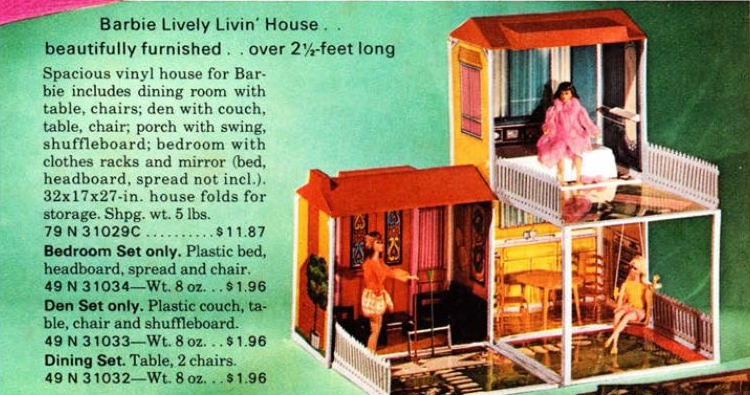
1970 Sears catalog entry for the Lively Livin’ House. Source: Wishbook Web. The 1970 catalog excerpt above lists not just the house itself, but also three individual rooms, sold separately: Bedroom Set, Den Set, and Dining Set. From the terse description, it seems as if these are just subsets of the full play set’s components (although this listing claims there is no bed or bedspread included with the Lively Livin’ House, other sources–including the box shown at top–disagree). But the Christmas catalog entries were often based on prototypes and concepts, as is the case here: besides the bedding confusion, note the red brick chimney on the lower left side of the house, and the densely-slatted fencing that differs from the final product. The real Lively furniture sets, rare-to-vanishing today, put their own spin on these rooms.
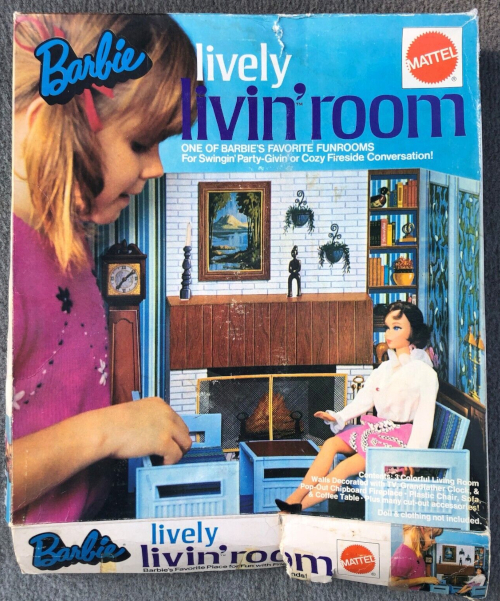
1970 Lively Livin’Room box art In fact, the “livin’room” set (probably the Den Set from the Sears catalog) does include the sofa, chair and table from the Lively Livin’ House, but in a different color palette (shuffleboard is not in evidence). The same was true of the Teen Dream Bedroom and Cookin’ Fun Kitchen furniture pieces. But it’s in the walls and floors (again with the walls and floors!) where the furniture sets really went in their own direction.
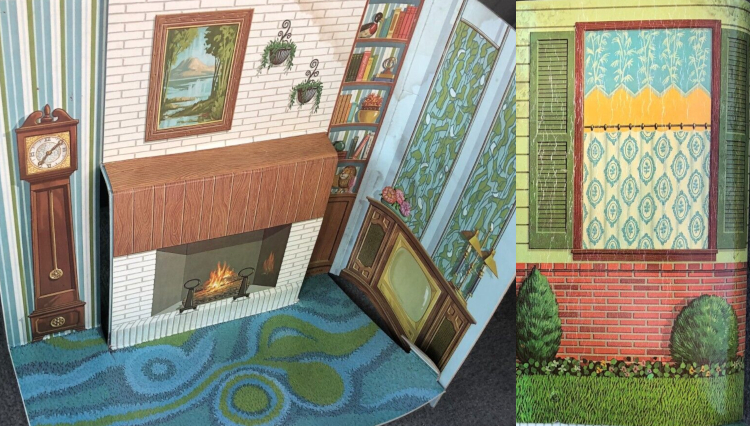
1970 Barbie Lively Livin’Room interior walls and floor (L) and exterior (R). Source for this and previous image: wonderwoman13 on eBay. They’re not as groovy as the Lively Livin’ House–then again, what is?–but still deeply Seventies. This living room is a little more family-oriented than the one in the Lively house, displaying grown-up touches along with that trippy carpet.
The wall had a simple dimensional feature that pushed the fireplace into the room, as shown above. The other two sets augmented their basic furnishings in the same way, with a dimensional bedroom dresser and kitchen sink. Like the livin’room, these rooms’ walls were new conceptions. Due to the rarity of the sets I have no images to share; however, Marl Davidson photographed them for her book on Barbie structures, and we included a snapshot of those pages when we recommended her book.
Well there you have it! It’s the end, for now at least, of the Many Abodes of Barbie series. Our final house isn’t technically the Lively Livin’ House of 1970, or even the same-y Surprise House of ’72, but rather the ’73 Country Living Home we visited last time. There are still some Seventies furniture sets we wish to discuss with you, but on the whole, Barbie’s focus during this decade was outside the home. Where might we find her as the next decade progresses?
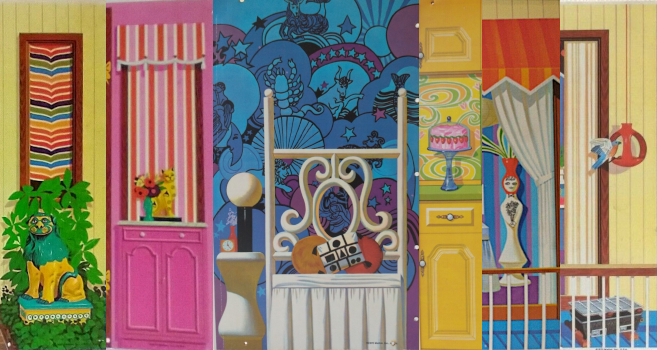
Where to next? This post is about Barbie’s early built environment. Apart from the Many Abodes of Barbie series, the most recent post in this category is about Cafe Today, and the most popular are those on Mattel Modern and Susy Goose furniture and on penthouse apartments. The overall most popular post on this site is about Mattel fashion booklets. Or just head up to the Table of Contents to see more options.
-
Who wore it best? Mary Quant edition
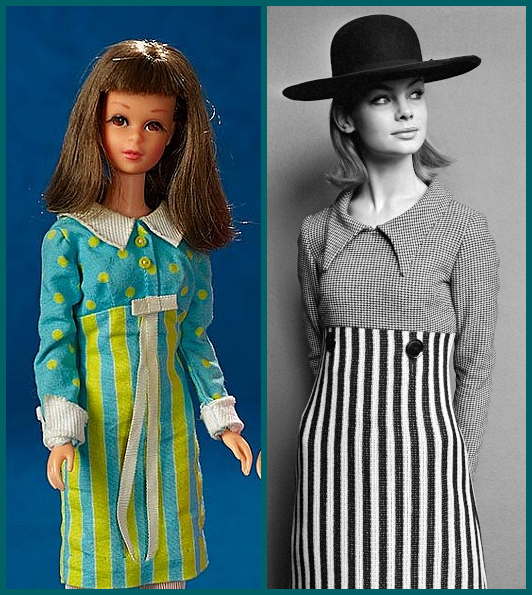
L: Francie wears It’s a Date (1966). Source: Theriault’s. R: Jean Shrimpton in Mary Quant, 1963. In her 1965 memoir Quant wrote, “When you break a rule, you automatically arrive at something different and this is fun. Take stripes, checks and polka dots. For years these were worn on their own or teamed with a plain colour. Nobody asked why. I believe in mixing patterns and colours wildly. So far as I’m concerned, spots go with stripes and checks.”
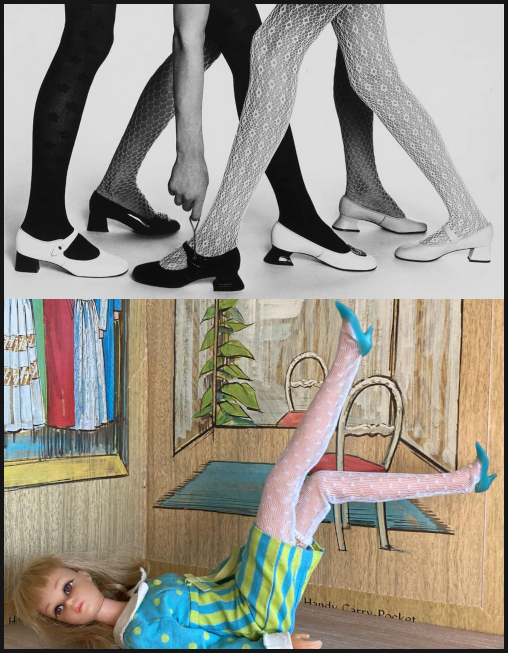
Top: From a 1965 advertisement for Mary Quant patterned tights. Bottom: Francie in It’s a Date. 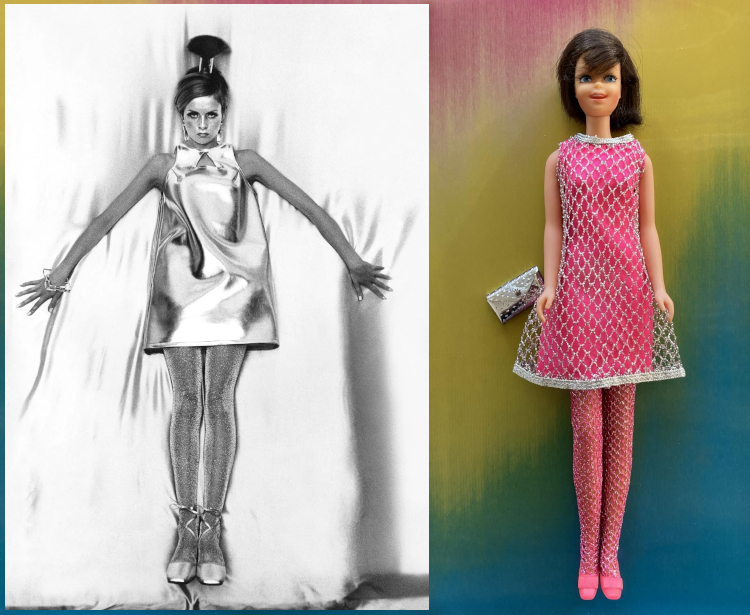
L: Twiggy in 1966, wearing glitter tights by Mary Quant. R: Casey in The Silver Cage (1968) (The above is not meant to claim that Silver Cage is a Mary Quant design–neither is the frock Twiggy wears here–but in the mid-60s Quant made great innovations in womens’ tights; the glitter ones of ’66 were a particular success.)
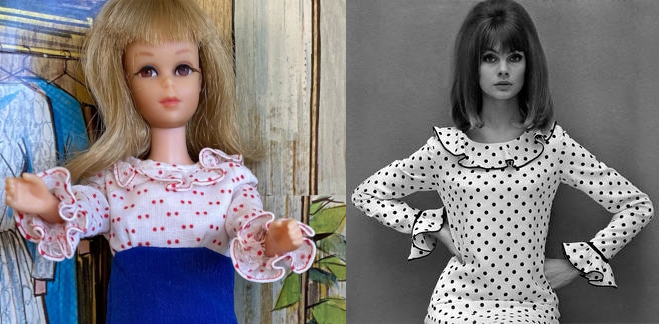
L: Francie in the Concert in the Park (1966) dress. R: Jean Shrimpton in Daddy’s Girl by Mary Quant for Ginger Group, 1964. 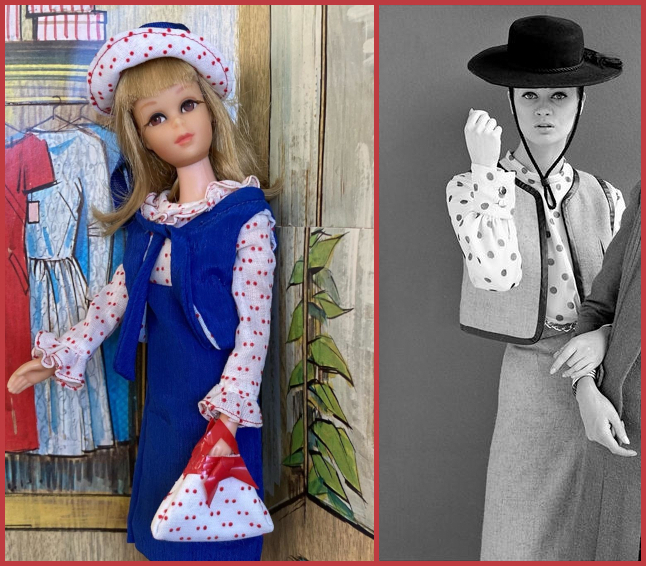
L: Francie in Concert in the Park. R: Celia Hammond in Coal Heaver by Mary Quant, 1962. A 1965 New Yorker piece covering a Mary Quant “Youthquake” fashion promotion for the States quotes from a brochure titled, “Youthquake Lingo (For Salespeople Only)”: “‘Super’ is the British way of saying O.K. All these Youthquake fashions are very much super, meaning O.K. ‘Smashing’ is the English word for ‘great,’ meaning the most exciting. And it’s a great word to use for the entire Youthquake collection. A ‘flakeout’ is so bad it’s really awful…”
When Francie hit the scene the following year, an article in Barbie Magazine titled “Say It In Mod” explained, “Mod is short for modern and it means new… Cool means anything that’s great… and so does fabby, and marvey and neat! In means anything that’s in style, out means anything that isn’t! Groovy and gear are the same as cool…” and so forth (as transcribed by BillyBoy* in Barbie: Her Life and Times).
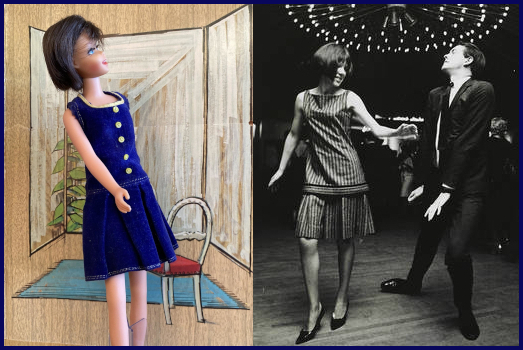
L: Casey in Pleat Neat (1967). R: Quant and husband/business partner Alexander Plunket Greene dance in New York City. Photographed for Life Magazine’s 1960 feature, “A British Couple’s Kooky Styles.” The preceding images of Quant, Shrimpton, Hammond, and unknown models in tights come from the Victoria and Albert Museum and its 2019 exhibition catalog, Mary Quant.
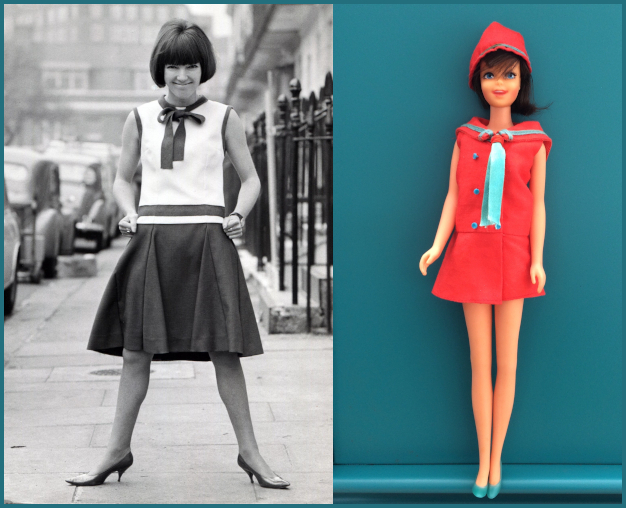
L: Mary Quant in London, 1961. R: Casey in Land Ho! (1969). Quant also wrote in ’65 that “there was a time when every girl under twenty yearned to look an experienced, sophisticated thirty… when every girl dreamed of a slinky black dress worn with very high heels. All this is in reverse with a vengeance now… their ambition is to look like Patty [sic] Boyd rather than Marlene Dietrich.” (Twiggy would be discovered the following year.)
I swear, that Pattie Boyd–herself a Teen-Age Fashion Model when she met future husband George Harrison in 1964, catapulting her to celebrity status–reminds me of someone I’ve seen…
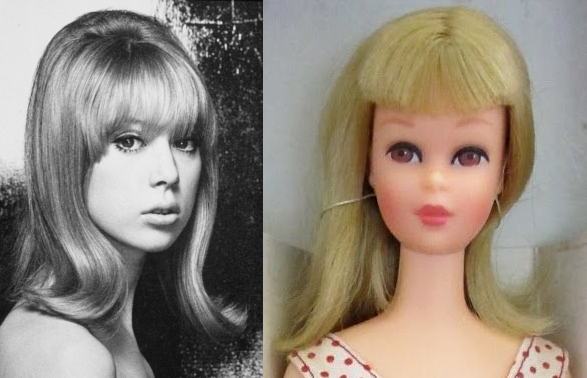
Mid-Sixties Pattie, meet mid-Sixties Francie. -
Dell Comics (1962-1963)
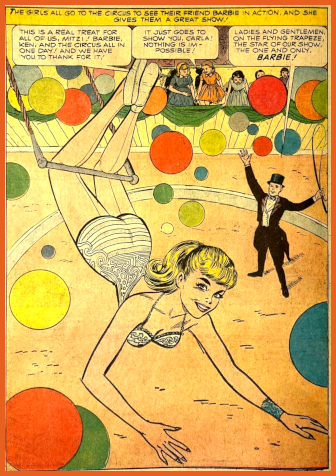
Barbie and Ken #3, May-July 1963. via Three Palms Vintage on eBay. From May of 1962 to August of ’63, Dell Comics released a 5-issue run of “Barbie and Ken” comic books. Contemporaneous with the Random House chapter books, the comics introduce a different vision of Barbie. Whereas the chapter books’ protagonist was a high school student, the comics’ Barbie is an adult with numerous careers: flight attendant, newspaper reporter, nurse, dental assistant, nightclub singer, circus performer, ballerina, meteorologist, and more. (Ken, meanwhile, is television producer, nightclub-owning songwriter/pianist, dentist, surgeon…)
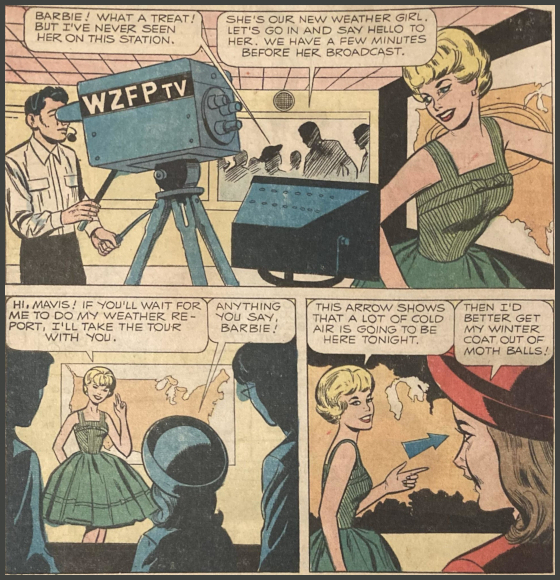
Where the chapter books show her learning from her mistakes, sometimes prone to doubt and insecurity, in the comics she is assured, unerring and impossibly talented–though she accepts compliments very graciously.
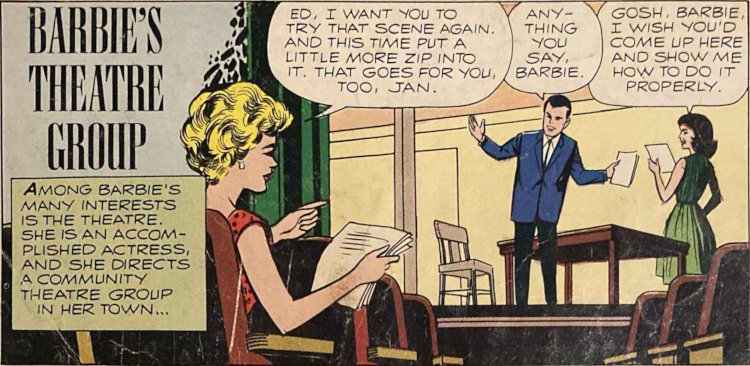
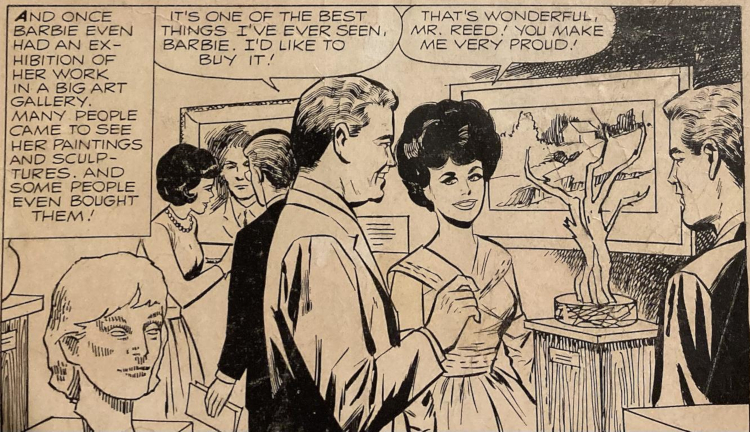
Everywhere she goes she is praised, and nothing can function without her. When she covers the fashion beat for a local newspaper, assistant Midge comes by to have her check some illustrations–but Barbie also drew the illustrations. And aren’t they lovely?
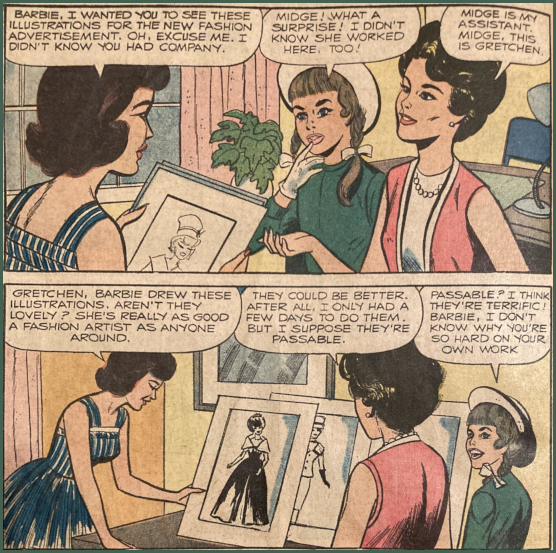
Later, when she goes to report on a fashion show, the designer asks Barbie to model for her.
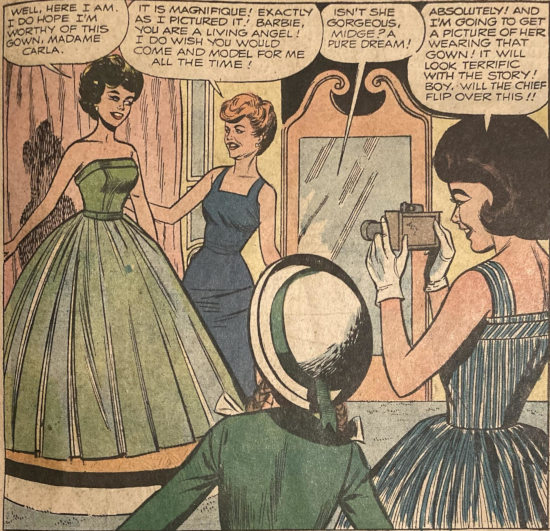
Despite all her poise and accomplishments, she relies on strange children to choose her furniture.
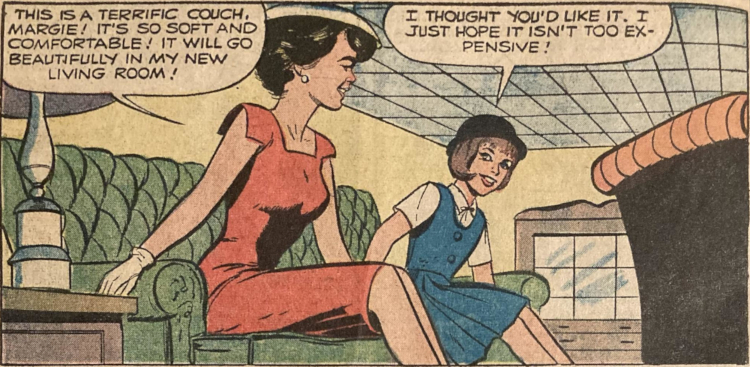
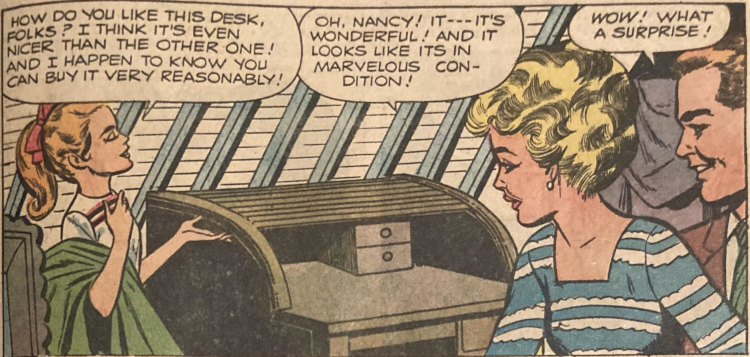
The children are all members of the Barbie Fan Club; each episode is set within a framing device of club members describing the time that they met Barbie. The best explanation for her reliance on the tastes of children, as well as her abundance of careers, is that the stories are all made up. In the first issue one of the children even admits her story was a dream; but does that admission strengthen or undermine the conclusion that the rest are fabrications, too?
Anyway, let’s talk illustrations, which are in a standard midcentury comic style. Outside of the fashion booklets, the comics are probably unmatched in density of character renderings–even the coloring books did not need multiple Barbies per page. Perhaps it’s a consequence of the need for mass illustrations that their quality varies so much. At times Barbie looks lovely, as the text insists.
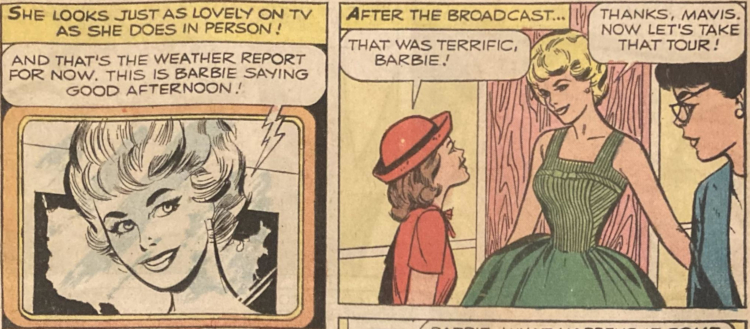
At other times her features are mismatched.
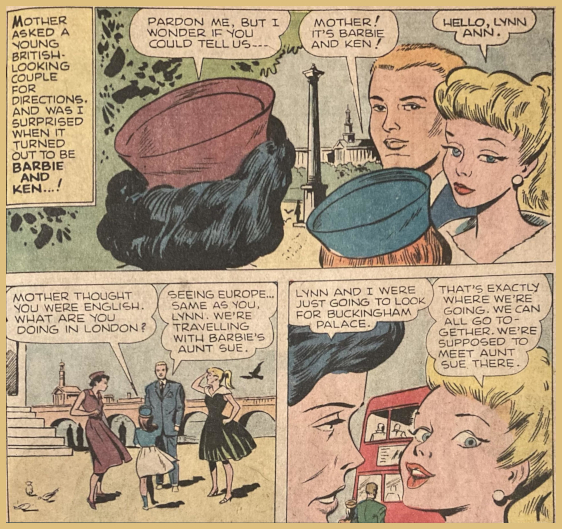
(A note on the story and Barbie’s virtue: as Ken is quick to clarify, the unwedded couple don’t just go gallivanting about Europe together; Barbie’s aunt, though absent from the action, chaperones them. In the episode where Barbie buys furniture for her new home it’s revealed that Barbie’s mother lives there with her. Dell’s Barbie is unquestionably a “nice” girl.)
Sometimes the illustration quality even varies from frame to frame, as in these excerpts from “The Barbie Fashion Show,” a local TV broadcast:
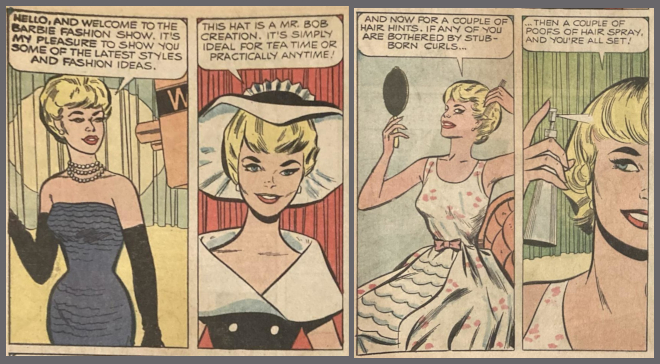
Making that face, before that curtain, while referencing Mr. Bob… it’s all a little too Twin Peaks!
You may have noticed by now that the panels are also chock full of legit Mattel-designed Barbie fashions. We’ve glimpsed Senior Prom, Solo in the Spotlight, Sheath Sensation, After Five, Movie Date, and more. Since the whole series rolled out over approximately one year, there are a lot of fashion repeats: we were happy to see our namesake fashion, Silken Flame, worn by Barbie, Midge, and an unknown model at Madame Carla’s salon.
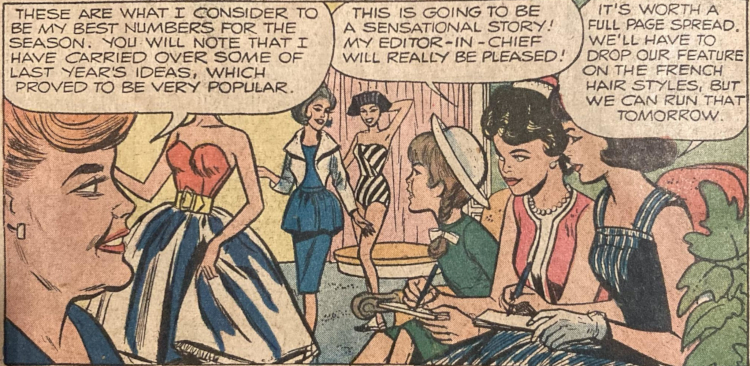
Midge dons Silken Flame to praise Barbie’s largely-unsung glory.
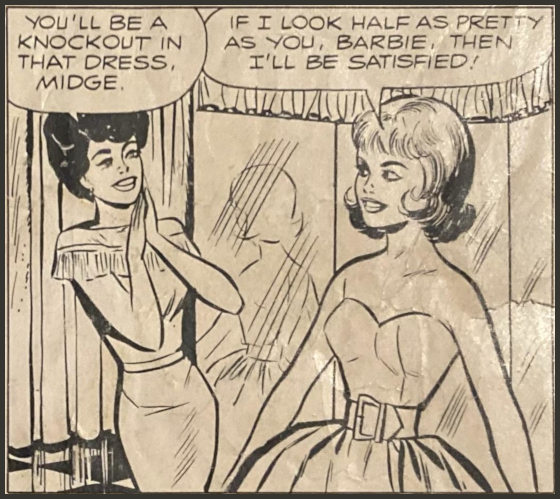
Barbie is at her most human getting weak-kneed over piles of money in a Monte Carlo casino, wearing Silken Flame in a de Stijl-influenced color scheme.
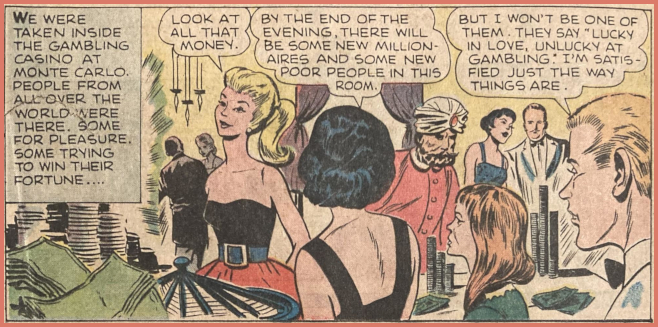
Ken’s satisfied. Is Barbie?
In issue #2 Barbie spends much of the first episode wearing a red-colored Cotton Casual version; then in the second episode she puts on her “new party dress,” which is Cotton Casual in blue!
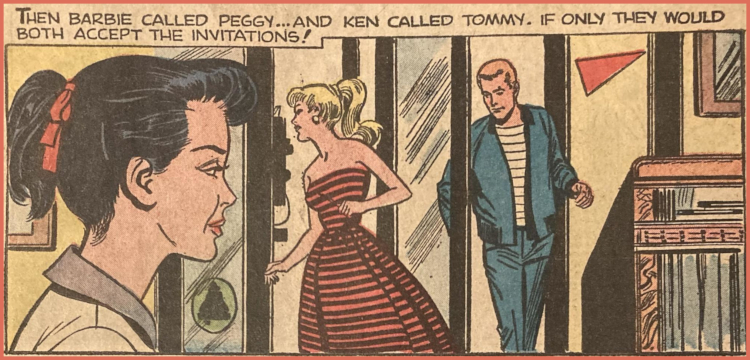
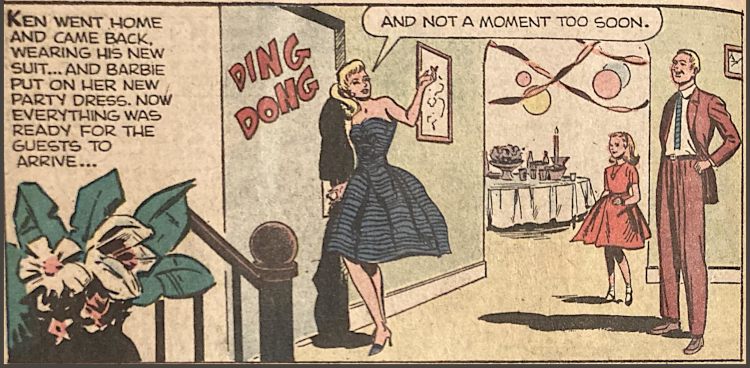
Despite our focus on hand-drawn illustration in this blog, our favorite images from this series are actually the doll photography used for the covers:
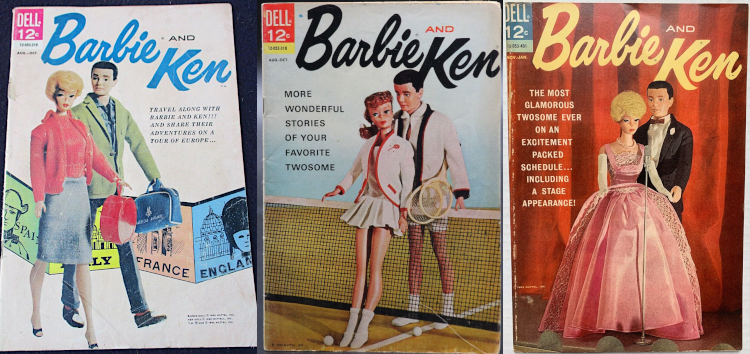
Dell Barbie and Ken issues 2, 4 and 5 covers via eBay. Worth framing. But that’s probably enough on the vintage comics, given that there were only five issues and the art style was pretty consistent throughout. Before we go, I hope you’ll appreciate Barbie’s midcentury couch, coffee table and “cheese” dip:
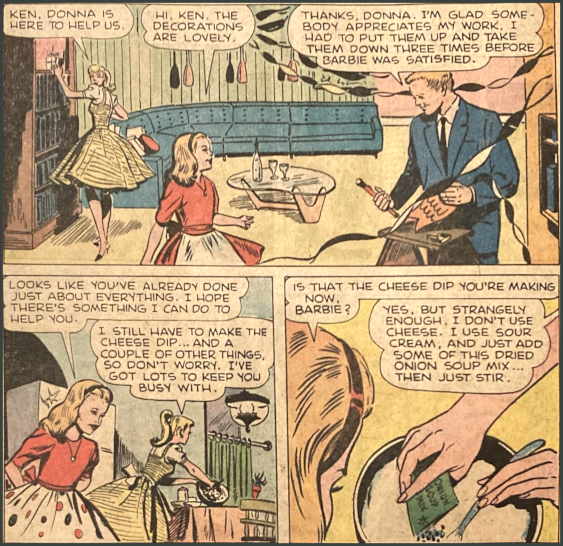
-
Not Barbie on TV
In an earlier post, we reviewed a handful of Barbie’s television appearances on early Barbie sets. But Barbie, her friends, and rivals watched other programs, too. Let’s view a few.
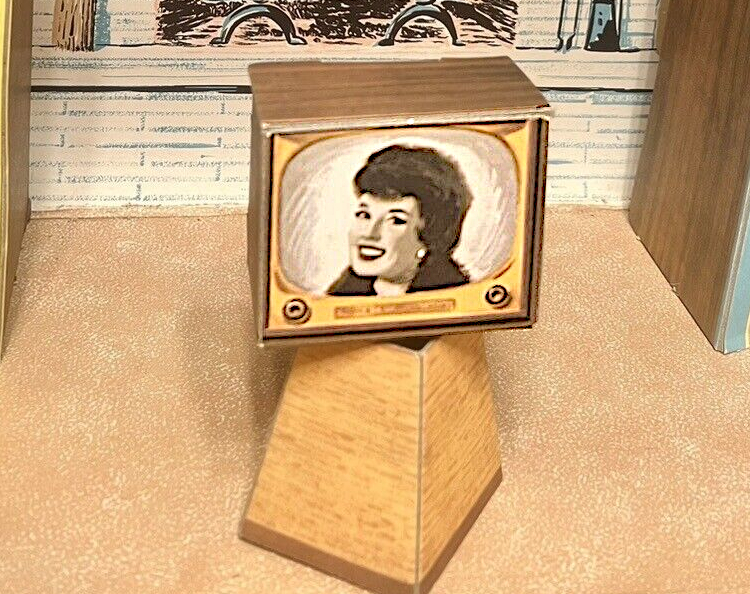
1963 Ideal Doll House television set. Source: 608samolly on eBay. First up is the 1963 Ideal house that was marketed for use by either Tammy or Barbie. This was a big house for its era, with kitchen, living room and bedroom in modern furnishings. On the black-and-white TV is a woman with Loretta Young looks and either a high fur collar or the most carefully-coiffured mullet on Earth.

1963 Ideal Doll House prototype in the ’63 Sears Christmas catalog. Source: christmas.musetechnical.com. Midge reclines in a prototype of the same house in the 1963 Sears catalog, with a similar show airing on the small TV in the built-in shelving unit at back. What looks like a second set, facing midge but lacking a screen, is actually a bulky side table or storage unit.
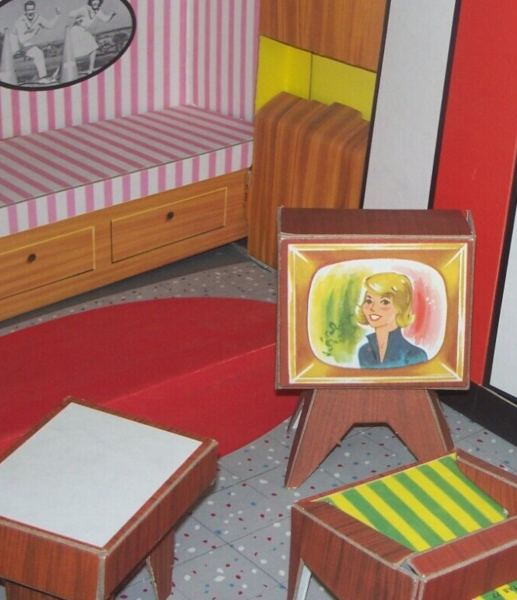
Tammy’s Ideal House / Tammy’s Playhouse television. Source: janetnmark2010 on eBay. Ideal also made a house especially for their own doll, Tammy, in ’63. Tammy’s Ideal House, sometimes Tammy’s Playhouse, has color TV, and she’s watching an unknown blonde–Tammy, the girl next door, was much less likely than Barbie to see herself on air.
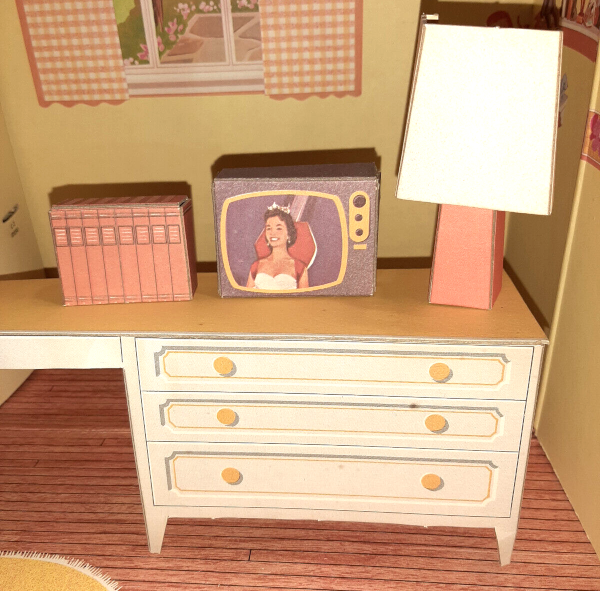
Littlechaps’ Living Room TV set. Source: 2bdebtfree on eBay. Over at the Littlechaps’ residence, still in ’63, the color TV shows a smiling brunette. This could be one of the Littlechap ladies, but we doubt it; like Tammy, they led private lives. This one looks a bit like a young Queen Elizabeth II, but for the lack of necklaces–maybe this is more of a homecoming queen, beauty queen or similar. The Bold Doll has an amazing article all about the Littlechaps, including images of the booklet advertising all their ephemera. Visible in the booklet (at the bottom of the article, but peruse the whole thing–it’s great) is a different (prototype) television, showing, in black and white, a possible newscaster or crooner before a microphone. The same version appeared on the Family Room’s packaging.
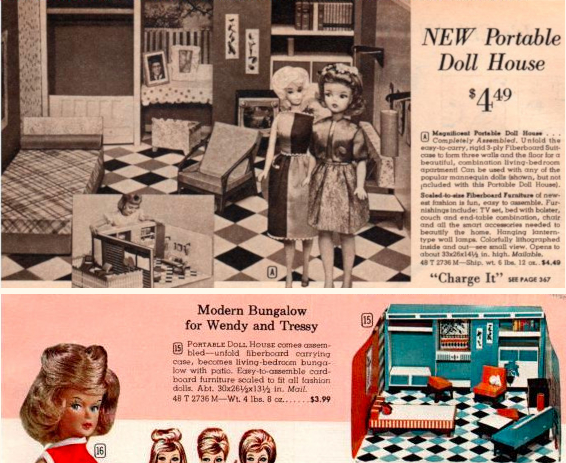
1963 and ’64 Montgomery Ward catalog listings for a “Portable Doll House” or bungalow for Barbie and/or Tammy and/or Wendy and/or Tressy. Source: christmas.musetechnical.com There was a glut of chipboard houses in 1963, imitators of Barbie’s original. Here’s a “Portable Doll House” we’ve only seen in Montgomery Ward’s catalogs, above. It looks like there’s a TV, but what’s on? Enhance!
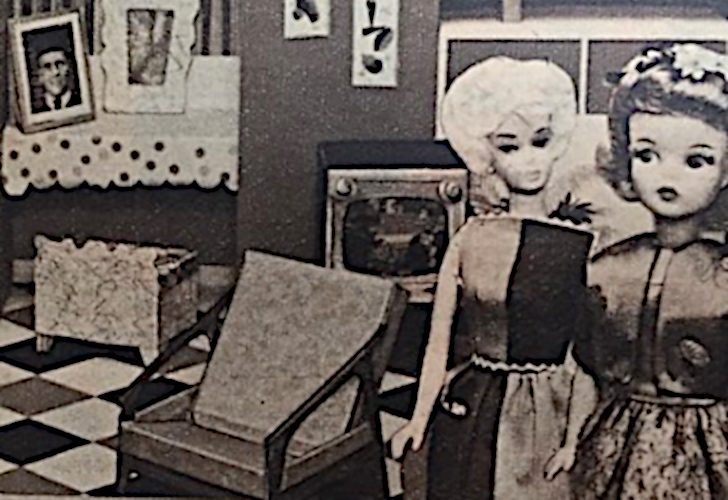
We’ll venture that that’s a landscape at night–it could be anything, though.
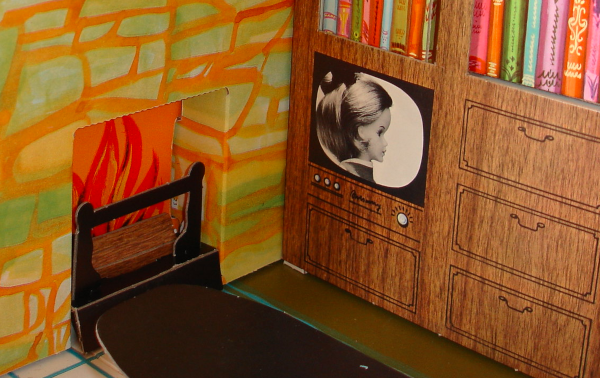
The telly in Tressy’s penthouse. Source: LaneyCummings on Flickr. In 1964 the housing market cooled, but we did get one new “clone” house, Tressy’s Penthouse. Tressy’s chic city lifestyle allowed for a modestly-sized, black-and-white television built into the shelves, and that does appear to be Tressy on screen.
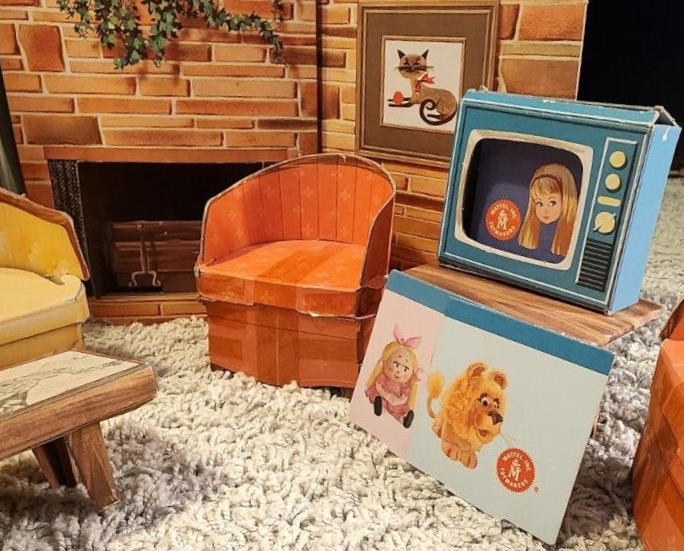
1964 Barbie and Skipper’s New Dream House television with alternate screens. Source: lovart on eBay. Barbie and Skipper got new digs in ’64 as well. For the first time, Barbie wasn’t on TV, but their color television offered a selection of different programs, some of which are shown above (there were more options on the backs of those cards, as well). This marks Skipper’s first television appearance.
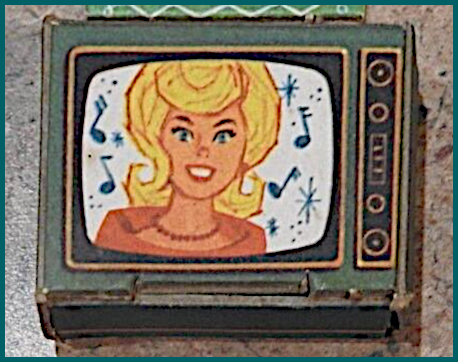
1965 Skipper’s Dream Room television. Source: bigrackdaddy on eBay. Skipper got her own room, with its own TV, in 1965. Since this looks like no other Barbie illustration in that time period, including multiple pictures of Barbie that came with the room, we’re forced to conclude that this is, surprisingly, not Barbie on Skipper’s TV. It looks a little like what Tammy was watching two years ago, though.
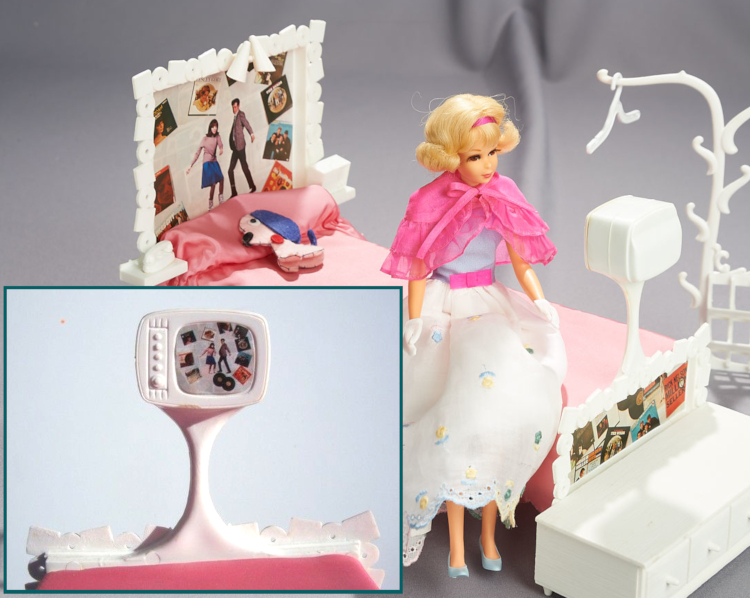
Francie’s 1966 Mod-a-Go-Go bed with built-in television. Sources: Theriault’s; Barbie List Holland. Francie’s 1966 bedroom set by Susy Goose included a small TV built into the bedframe. As shown in the inset, the collage on her headboard is repeated in miniature on TV. The collage includes photographs of teens dancing, record sleeves, and two record albums. Were there shows that looked this way in ’66?
Barbie and pals continued to own televisions after these years, but they were diminished in size, illustrated into the walls or shelving, and typically turned off. In the Seventies Barbie favored a more active lifestyle, which TV didn’t suit–except, of course, for her 1972 “busy” TV set, perfect for the girl on the go. That set was tuned, naturally, to a performance by Barbie.
Smile, ladies!

Where to next? This post is about Barbie’s early built environment. Apart from the Many Abodes of Barbie series, the most recent post in this category is about Cafe Today, and the most popular are those on Mattel Modern and Susy Goose furniture and on penthouse apartments. The overall most popular post on this site is about Mattel fashion booklets. Or just head up to the Table of Contents to see more options.
-
Who wore it best? Airborne edition
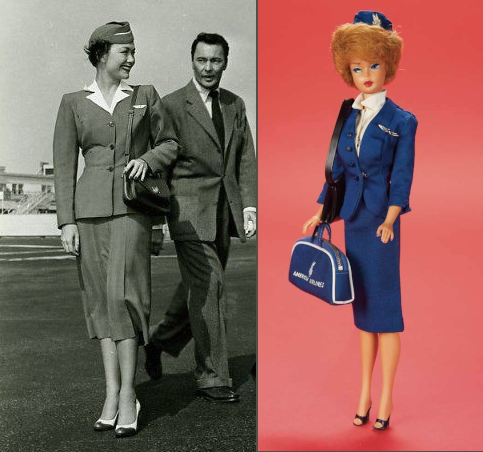
L: Jane Wyman as an American Airlines stewardess in MGM’s “Three Guys Named Mike,” 1951. R: Barbie as the same from 1961; source: kyoto-jky74 on eBay. 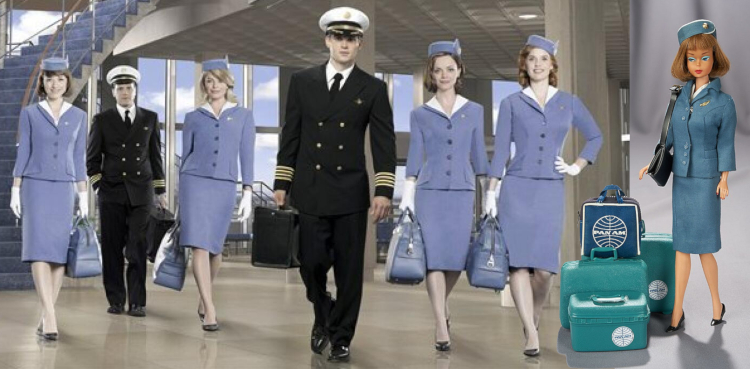
L: the cast of ABC’s “Pan Am,” set in 1963. R: Barbie as Pan Am stewardess (with extra luggage) from 1966; source: Theriault’s. The original Barbie Pan Am ensemble included white gloves and closed-toed black shoes. 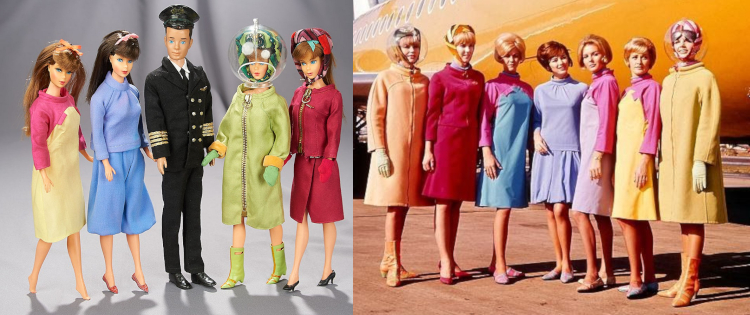
L: Barbie in Marx Braniff air hostess costumes from 1967, with Ken as pilot; source: Theriault’s. R: Braniff International Airlines uniforms designed by Emilio Pucci, 1965. 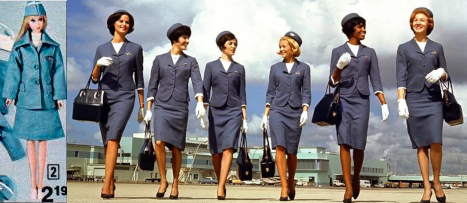
L: Barbie in Air Hostess/Stewardess costume from 1973 JC Penney catalog (advertised there since ’70); source: christmas.musetechnical .com. R: Delta airlines stewardesses, 1960s. 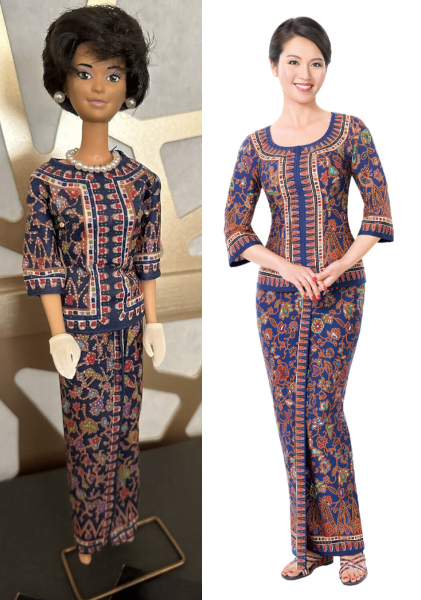
L: Barbie as Singapore Girl from 1993 (the gloves and pearls were added by the owner); source: fashionibly_favored on eBay. R: Model wearing sarong kebaya designed for Singapore Airlines by Pierre Balmain in 1972. 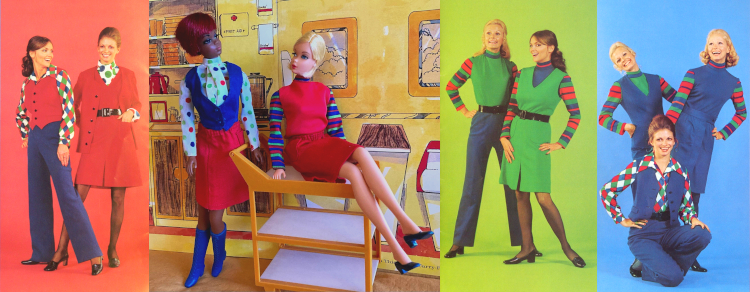
Left, right, and center right: 1973 United Airlines uniforms by Jean Louis. Center left: vintage Julia and repro Hair Fair in 1973 Get-Ups ‘N’ Go United Airlines ensembles (with pak boots for Julia–other historical shots of the flight attendant uniform show it styled that way). 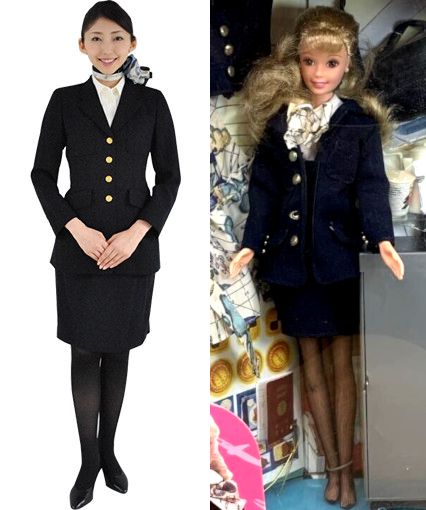
L: model wearing Japan Airlines’ flight attendant uniform designed by Yoshie Inaba, 1996. R: 1997 Barbie as Japan Airlines flight attendant; source: pioneer-land-japan on eBay. -
Sidebar: All the Barbie and friends illustrations on mod house exteriors

Tutti, Skipper, Barbie and Francie cavort on the exterior of the Barbie Family Deluxe House, available in 1966. Source: jll1966 on eBay. 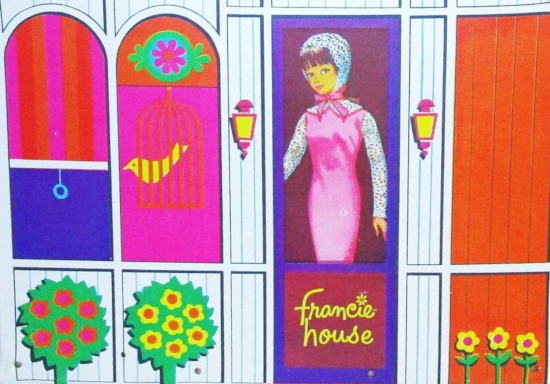
1966 “francie house.” Source: Fallsavevintage on Etsy. 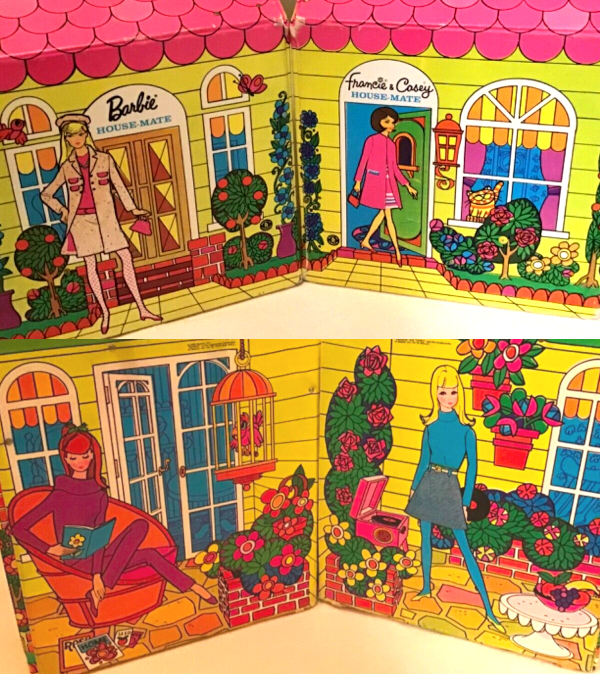
Barbie and Francie+Casey 1967 House-Mates exteriors, front (top) and back. Source: misscarol on eBay. 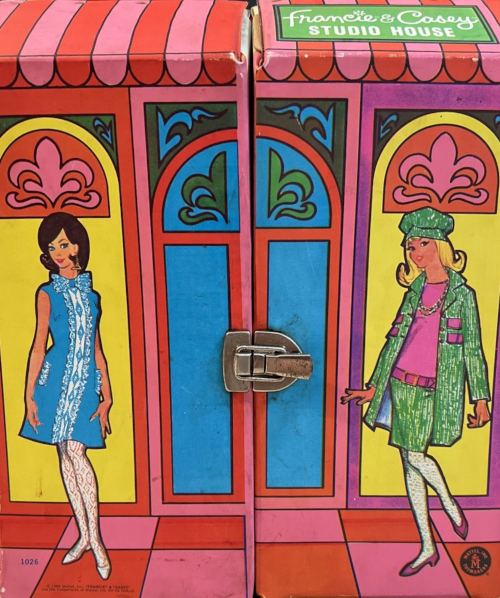
Francie & Casey on their circa-1967 Studio House. Source: purplejojo on eBay. 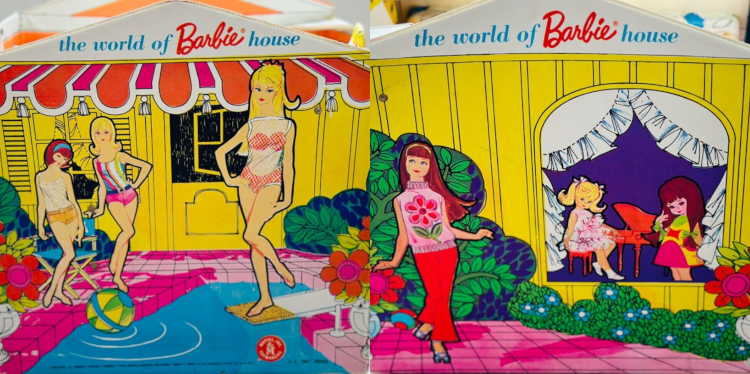
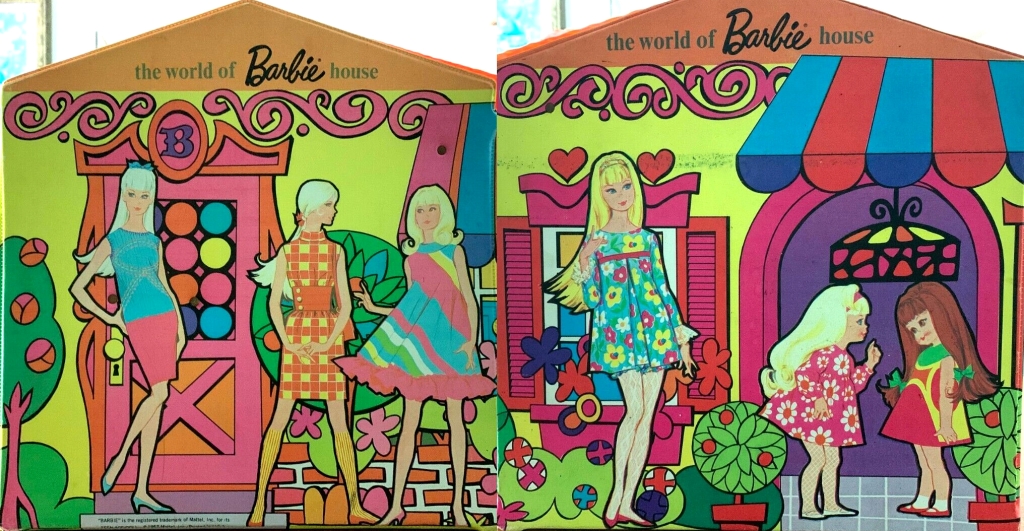
Front (L) and back of the World of Barbie Family House, 1967 (above) showing Barbie, Francie, Casey, Skipper, Tutti, and Chris, and 1968, showing Barbie, Stacey, Francie, Tutti, and Chris. Sources: debonbay on eBay, moxie213 on eBay. Note: the character illustrations on the ’67 World of Barbie house above also appear in “World of Barbie Fashions” booklets from 1966-67, and the same illustrations and positioning are used on the exterior of the (otherwise differently designed) elusive German structure, Villa Barbie.
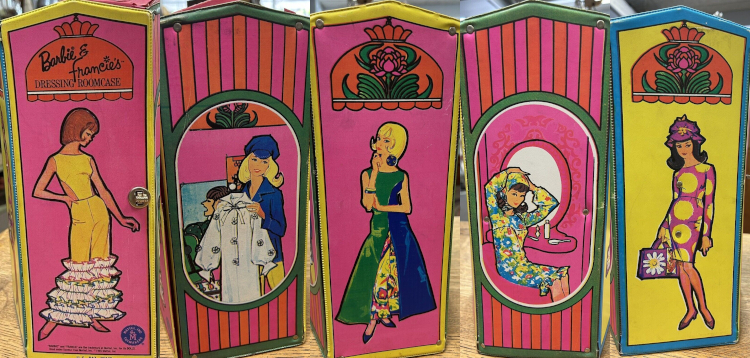
Exterior of the five-sided 1968 Dressing Room case. Source: the_old_vineyard on eBay. For more habitable case illustrations, see the Sleep-n-Keep section in our entry on carrying cases. Elsewhere in mod section of that article you’ll also find examples of repeated character imagery from the ’68 World of Barbie house and the Francie & Casey Studio House,
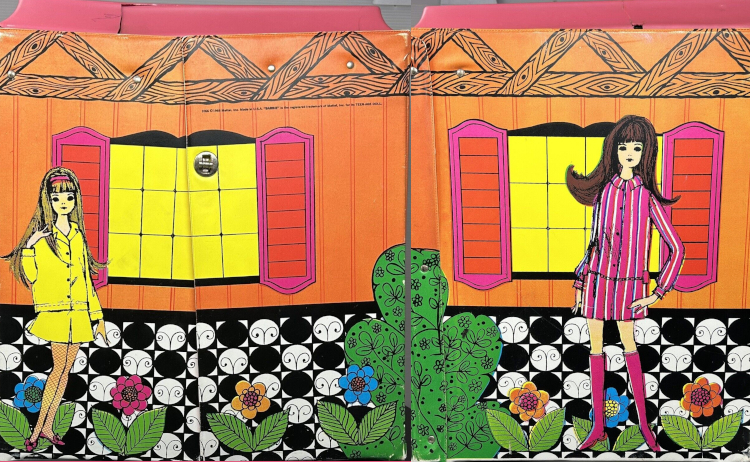
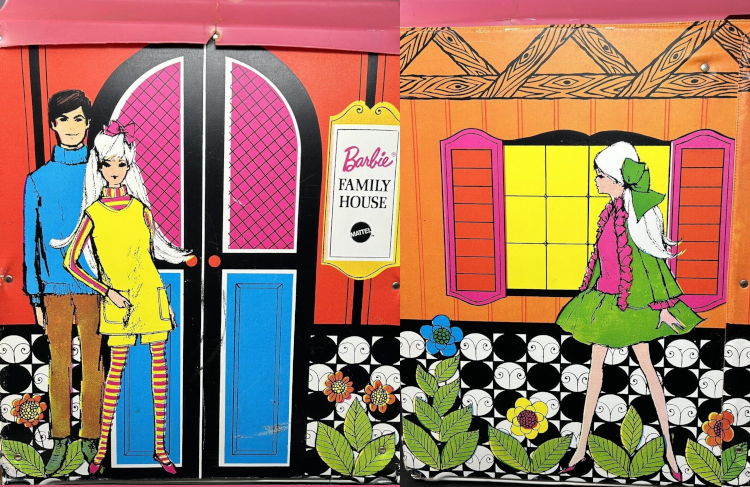
Four views of the 1969 Barbie Family House, showing Barbie, Ken, Stacey and Skipper, and in which Barbie and Ken are implied to be cohabitating. Source: pickerscornerllc on eBay. -
The Many Abodes of Barbie, Part VI: 1969
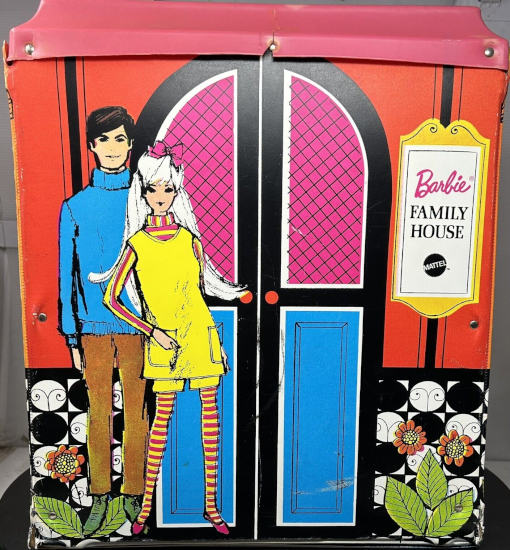
1969 Barbie New Family House exterior. Source: pickerscornerllc on eBay. When we last checked in on Barbie, she was living in a two-room “World of Barbie Family House,” her most sprawling home since her chipboard days. In 1969 life got better again for Barbie with the New Family House. At a glance the folded-up house, above, looks pretty similar to the old family house; but while that one compressed to a thin slab, the new house could only fold to an almost-cube; the extra space needed was due to its new third room.
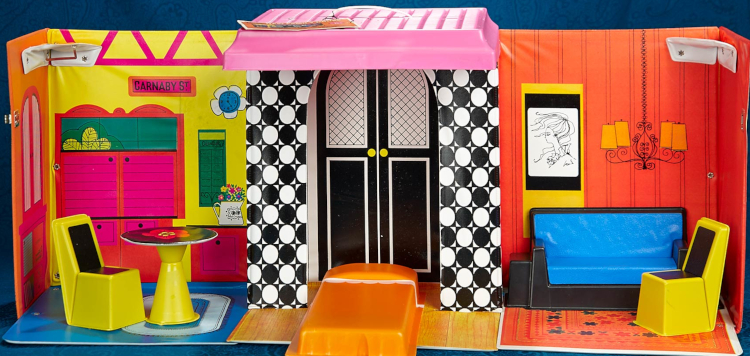
1969 Barbie New Family House interior with furniture. Source: Theriault’s. Another luxurious touch: unlike previous years, the 1969 house’s furniture (bed, sofa, table and two chairs) could be freely rearranged. Above, we see but one of many possible layouts, this one with the bed pushed up close to those double doors. A strange choice, but also the arrangement shown in some of Mattel’s promotional images, including the one printed on the tag tied to the handle on the roof above. At least some of Mattel’s images, including some from fashion booklets, show the bed in the leftmost room, and the table and both chairs in the middle space.
Other changes spoke less to luxury. Compared to earlier houses in the mod aesthetic, the New Family House’s walls are practically unadorned: a black-and-white sketch of Barbie with the wind in her hair, a wrought-iron-look chandelier, a flower-shaped clock and a street sign reading “Carnaby St.” are among the few eye-catching pieces lithographed to its vinyl walls (the area rugs and “hardwood” in the front room are nice touches, though). Maybe Barbie had started to grow tired of moving and decorating just to pack up and move again… or maybe her new “roommates” didn’t share her style sensibilities?
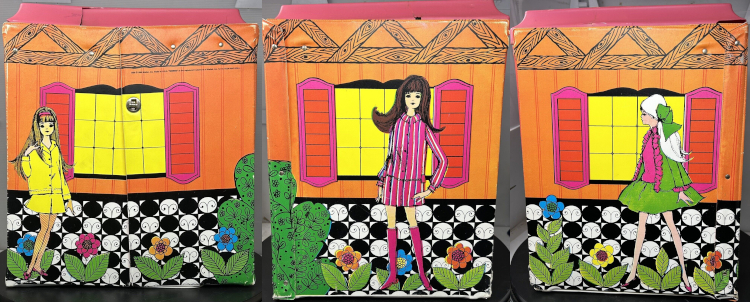
1969 Barbie New Family House exterior. Source: pickerscornerllc on eBay. Perhaps the biggest change of all for Barbie is the suggestion that she and Ken had taken their relationship to the next level: shown at top, the pair pose like newlyweds in front of this new family house (though we know, of course, that they never officially married). On the other faces of the exterior, Barbie, Francie and Stacey creep through the flower beds and peer in at the windows. Like the interior, the exterior is otherwise lean on detail.
The New Family House stayed around until 1972. The following year, the Barbie Country Living Home was architecturally similar enough that we include it here.
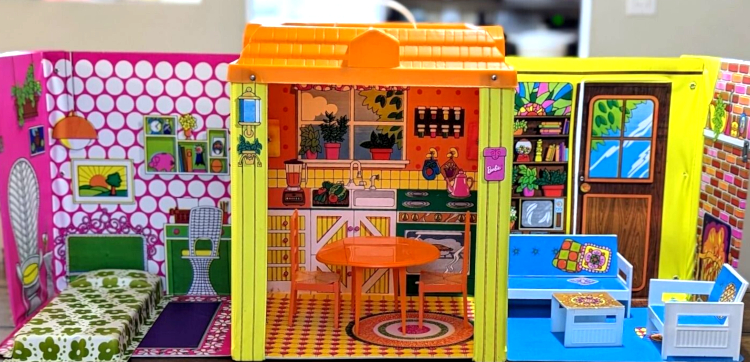
1973 Barbie Country Living Home interior. Source: janzy67 on eBay. The structure was largely unchanged from the New Family House. The method for folding and carrying was identical; outside, the roof was slightly altered, and a functioning door opened out from the rear of the living room, above right. On the interior, the big architectural change was that full walls had been erected between the three rooms, with functional saloon doors connecting living room to kitchen and dutch doors between kitchen and bedroom.
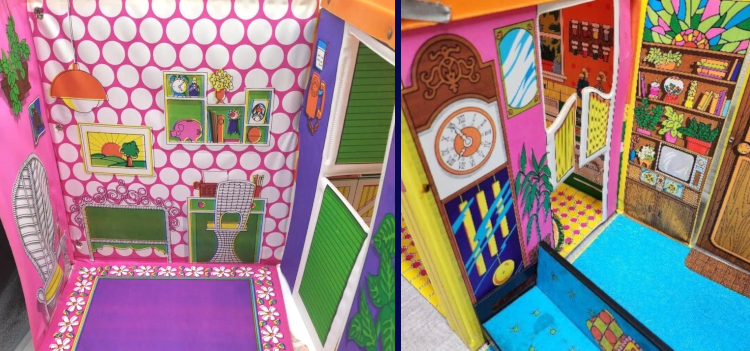
1973 Barbie Country Living Home details, including interior doors. Sources: itznthemail and embat_7, both on eBay. The furniture was all-new, too, other than the bed, which was only recolored. The kitchen table and two chairs, sofa, easy chair and tile-topped coffee table are all variations on the furnishings common to ’70s sets including Jamie’s Party Penthouse and the Lively Living/Surprise House.
Unlike its predecessor, the Country Living Home’s rooms were indicated by the detailed illustrations on the walls: bookshelves, television and grandfather clock in the living room, cabinets and appliances in the kitchen, wicker chairs, headboard and wall phone (!) in the bedroom. The exterior was also rich with inviting and homey details in wood, brick, and greenery, but no characters–the characters’ appearances on the sides of structures ended with the mod period.
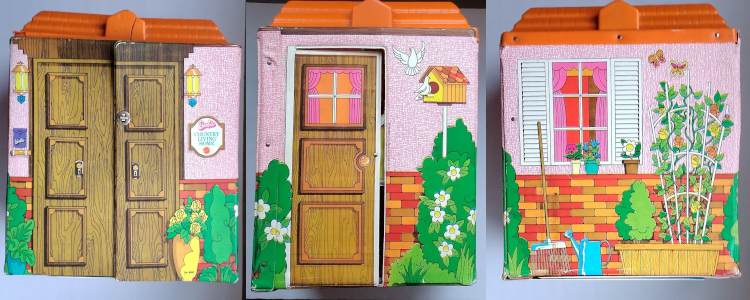
1973 Barbie Country Living Home exterior. Source: kelfis11 on eBay. The New Family Home was the last of the mod abodes, but the Country Living Home wasn’t quite the first post-mod one. Next time, we’ll see what came between them.
-
Who wore it best? Mary Quant edition

L: Francie wears It’s a Date (1966). Source: Theriault’s. R: Jean Shrimpton in Mary Quant, 1963. In her 1965 memoir Quant wrote, “When you break a rule, you automatically arrive at something different and this is fun. Take stripes, checks and polka dots. For years these were worn on their own or teamed with a plain colour. Nobody asked why. I believe in mixing patterns and colours wildly. So far as I’m concerned, spots go with stripes and checks.”

Top: From a 1965 advertisement for Mary Quant patterned tights. Bottom: Francie in It’s a Date. 
L: Twiggy in 1966, wearing glitter tights by Mary Quant. R: Casey in The Silver Cage (1968) (The above is not meant to claim that Silver Cage is a Mary Quant design–neither is the frock Twiggy wears here–but in the mid-60s Quant made great innovations in womens’ tights; the glitter ones of ’66 were a particular success.)

L: Francie in the Concert in the Park (1966) dress. R: Jean Shrimpton in Daddy’s Girl by Mary Quant for Ginger Group, 1964. 
L: Francie in Concert in the Park. R: Celia Hammond in Coal Heaver by Mary Quant, 1962. A 1965 New Yorker piece covering a Mary Quant “Youthquake” fashion promotion for the States quotes from a brochure titled, “Youthquake Lingo (For Salespeople Only)”: “‘Super’ is the British way of saying O.K. All these Youthquake fashions are very much super, meaning O.K. ‘Smashing’ is the English word for ‘great,’ meaning the most exciting. And it’s a great word to use for the entire Youthquake collection. A ‘flakeout’ is so bad it’s really awful…”
When Francie hit the scene the following year, an article in Barbie Magazine titled “Say It In Mod” explained, “Mod is short for modern and it means new… Cool means anything that’s great… and so does fabby, and marvey and neat! In means anything that’s in style, out means anything that isn’t! Groovy and gear are the same as cool…” and so forth (as transcribed by BillyBoy* in Barbie: Her Life and Times).

L: Casey in Pleat Neat (1967). R: Quant and husband/business partner Alexander Plunket Greene dance in New York City. Photographed for Life Magazine’s 1960 feature, “A British Couple’s Kooky Styles.” The preceding images of Quant, Shrimpton, Hammond, and unknown models in tights come from the Victoria and Albert Museum and its 2019 exhibition catalog, Mary Quant.

L: Mary Quant in London, 1961. R: Casey in Land Ho! (1969). Quant also wrote in ’65 that “there was a time when every girl under twenty yearned to look an experienced, sophisticated thirty… when every girl dreamed of a slinky black dress worn with very high heels. All this is in reverse with a vengeance now… their ambition is to look like Patty [sic] Boyd rather than Marlene Dietrich.” (Twiggy would be discovered the following year.)
I swear, that Pattie Boyd–herself a Teen-Age Fashion Model when she met future husband George Harrison in 1964, catapulting her to celebrity status–reminds me of someone I’ve seen…

Mid-Sixties Pattie, meet mid-Sixties Francie.
